Sustainable tourism
Related sdgs, promote sustained, inclusive and sustainable ....


Description
Publications.
Tourism is one of the world's fastest growing industries and an important source of foreign exchange and employment, while being closely linked to the social, economic, and environmental well-being of many countries, especially developing countries. Maritime or ocean-related tourism, as well as coastal tourism, are for example vital sectors of the economy in small island developing States (SIDS) and coastal least developed countries (LDCs) (see also: The Potential of the Blue Economy report as well as the Community of Ocean Action on sustainable blue economy).
The World Tourism Organization defines sustainable tourism as “tourism that takes full account of its current and future economic, social and environmental impacts, addressing the needs of visitors, the industry, the environment and host communities".
Based on General assembly resolution 70/193, 2017 was declared as the International Year of Sustainable Tourism for Development.
In the 2030 Agenda for Sustainable Development SDG target 8.9, aims to “by 2030, devise and implement policies to promote sustainable tourism that creates jobs and promotes local culture and products”. The importance of sustainable tourism is also highlighted in SDG target 12.b. which aims to “develop and implement tools to monitor sustainable development impacts for sustainable tourism that creates jobs and promotes local culture and products”.
Tourism is also identified as one of the tools to “by 2030, increase the economic benefits to Small Island developing States and least developed countries” as comprised in SDG target 14.7.
In the Rio+20 outcome document The Future We want, sustainable tourism is defined by paragraph 130 as a significant contributor “to the three dimensions of sustainable development” thanks to its close linkages to other sectors and its ability to create decent jobs and generate trade opportunities. Therefore, Member States recognize “the need to support sustainable tourism activities and relevant capacity-building that promote environmental awareness, conserve and protect the environment, respect wildlife, flora, biodiversity, ecosystems and cultural diversity, and improve the welfare and livelihoods of local communities by supporting their local economies and the human and natural environment as a whole. ” In paragraph 130, Member States also “call for enhanced support for sustainable tourism activities and relevant capacity-building in developing countries in order to contribute to the achievement of sustainable development”.
In paragraph 131, Member States “encourage the promotion of investment in sustainable tourism, including eco-tourism and cultural tourism, which may include creating small- and medium-sized enterprises and facilitating access to finance, including through microcredit initiatives for the poor, indigenous peoples and local communities in areas with high eco-tourism potential”. In this regard, Member States also “underline the importance of establishing, where necessary, appropriate guidelines and regulations in accordance with national priorities and legislation for promoting and supporting sustainable tourism”.
In 2002, the World Summit on Sustainable Development in Johannesburg called for the promotion of sustainable tourism development, including non-consumptive and eco-tourism, in Chapter IV, paragraph 43 of the Johannesburg Plan of Implementation.
At the Johannesburg Summit, the launch of the “Sustainable Tourism – Eliminating Poverty (ST-EP) initiative was announced. The initiative was inaugurated by the World Tourism Organization, in collaboration with UNCTAD, in order to develop sustainable tourism as a force for poverty alleviation.
The UN Commission on Sustainable Development (CSD) last reviewed the issue of sustainable tourism in 2001, when it was acting as the Preparatory Committee for the Johannesburg Summit.
The importance of sustainable tourism was also mentioned in Agenda 21.
For more information and documents on this topic, please visit this link
UNWTO Annual Report 2015
2015 was a landmark year for the global community. In September, the 70th Session of the United Nations General Assembly adopted the Sustainable Development Goals (SDGs), a universal agenda for planet and people. Among the 17 SDGs and 169 associated targets, tourism is explicitly featured in Goa...
UNWTO Annual Report 2016
In December 2015, the United Nations General Assembly declared 2017 as the International Year of Sustainable Tourism for Development. This is a unique opportunity to devote a year to activities that promote the transformational power of tourism to help us reach a better future. This important cele...
Emerging Issues for Small Island Developing States
The 2012 UNEP Foresight Process on Emerging Global Environmental Issues primarily identified emerging environmental issues and possible solutions on a global scale and perspective. In 2013, UNEP carried out a similar exercise to identify priority emerging environmental issues that are of concern to ...
Transforming our World: The 2030 Agenda for Sustainable Development
This Agenda is a plan of action for people, planet and prosperity. It also seeks to strengthen universal peace in larger freedom, We recognize that eradicating poverty in all its forms and dimensions, including extreme poverty, is the greatest global challenge and an indispensable requirement for su...
15 Years of the UNWTO World Tourism Network on Child Protection: A Compilation of Good Practices
Although it is widely recognized that tourism is not the cause of child exploitation, it can aggravate the problem when parts of its infrastructure, such as transport networks and accommodation facilities, are exploited by child abusers for nefarious ends. Additionally, many other factors that contr...
Towards Measuring the Economic Value of Wildlife Watching Tourism in Africa
Set against the backdrop of the ongoing poaching crisis driven by a dramatic increase in the illicit trade in wildlife products, this briefing paper intends to support the ongoing efforts of African governments and the broader international community in the fight against poaching. Specifically, this...
Status and Trends of Caribbean Coral Reefs: 1970-2012
Previous Caribbean assessments lumped data together into a single database regardless of geographic location, reef environment, depth, oceanographic conditions, etc. Data from shallow lagoons and back reef environments were combined with data from deep fore-reef environments and atolls. Geographic c...
Natural Resources Forum: Special Issue Tourism
The journal considers papers on all topics relevant to sustainable development. In addition, it dedicates series, issues and special sections to specific themes that are relevant to the current discussions of the United Nations Commission on Sustainable Development (CSD)....
Thailand: Supporting Sustainable Development in Thailand: A Geographic Clusters Approach
Market forces and government policies, including the Tenth National Development Plan (2007-2012), are moving Thailand toward a more geographically specialized economy. There is a growing consensus that Thailand’s comparative and competitive advantages lie in amenity services that have high reliance...
Road Map on Building a Green Economy for Sustainable Development in Carriacou and Petite Martinique, Grenada
This publication is the product of an international study led by the Division for Sustainable Development (DSD) of the United Nations Department of Economic and Social Affairs (UNDESA) in cooperation with the Ministry of Carriacou and Petite Martinique Affairs and the Ministry of Environment, Foreig...
Natural Resources Forum, a United Nations Sustainable Development Journal (NRF)
Natural Resources Forum, a United Nations Sustainable Development Journal, seeks to address gaps in current knowledge and stimulate relevant policy discussions, leading to the implementation of the sustainable development agenda and the achievement of the Sustainable...
UN Ocean Conference 2025
Our Ocean, Our Future, Our Responsibility “The ocean is fundamental to life on our planet and to our future. The ocean is an important source of the planet’s biodiversity and plays a vital role in the climate system and water cycle. The ocean provides a range of ecosystem services, supplies us with
UN Ocean Conference 2022
The UN Ocean Conference 2022, co-hosted by the Governments of Kenya and Portugal, came at a critical time as the world was strengthening its efforts to mobilize, create and drive solutions to realize the 17 Sustainable Development Goals by 2030.
58th Session of the Commission for Social Development – CSocD58
22nd general assembly of the united nations world tourism organization, world tourism day 2017 official celebration.
This year’s World Tourism Day, held on 27 September, will be focused on Sustainable Tourism – a Tool for Development. Celebrated in line with the 2017 International Year of Sustainable Tourism for Development, the Day will be dedicated to exploring the contribution of tourism to the Sustainable Deve
World Tourism Day 2016 Official Celebration
Accessible Tourism for all is about the creation of environments that can cater for the needs of all of us, whether we are traveling or staying at home. May that be due to a disability, even temporary, families with small children, or the ageing population, at some point in our lives, sooner or late
4th Global Summit on City Tourism
The World Tourism Organisation (UNWTO) and the Regional Council for Tourism of Marrakesh with support of the Government of Morroco are organizing the 4th Global Summit on City Tourism in Marrakesh, Morroco (9-10 December 2015). International experts in city tourism, representatives of city DMOs, of
2nd Euro-Asian Mountain Resorts Conference
The World Tourism Organisation (UNWTO) and Ulsan Metropolitan City with support of the Government of the Republic of Korea are organizing the 2nd Euro-Asian Mountain Resorts Conference, in Ulsan, Republic of Korea (14 - 16 October 2015). Under the title “Paving the Way for a Bright Future for Mounta
21st General Assembly of the United Nations World Tourism Organization
Unwto regional conference enhancing brand africa - fostering tourism development.
Tourism is one of the Africa’s most promising sectors in terms of development, and represents a major opportunity to foster inclusive development, increase the region’s participation in the global economy and generate revenues for investment in other activities, including environmental preservation.
- January 2017 International Year of Tourism In the context of the universal 2030 Agenda for Sustainable Development and the Sustainable Development Goals (SDGs), the International Year aims to support a change in policies, business practices and consumer behavior towards a more sustainable tourism sector that can contribute to the SDGs.
- January 2015 Targets 8.9, 12 b,14.7 The 2030 Agenda for Sustainable Development commits Member States, through Sustainable Development Goal Target 8.9 to “devise and implement policies to promote sustainable tourism that creates jobs and promotes local culture and products”. The importance of sustainable tourism, as a driver for jobs creation and the promotion of local culture and products, is also highlighted in Sustainable Development Goal target 12.b. Tourism is also identified as one of the tools to “increase [by 2030] the economic benefits to Small Island developing States and least developed countries”, through Sustainable Development Goals Target 14.7.
- January 2012 Future We Want (Para 130-131) Sustainable tourism is defined as a significant contributor “to the three dimensions of sustainable development” thanks to its close linkages to other sectors and its ability to create decent jobs and generate trade opportunities. Therefore, Member States recognize “the need to support sustainable tourism activities and relevant capacity-building that promote environmental awareness, conserve and protect the environment, respect wildlife, flora, biodiversity, ecosystems and cultural diversity, and improve the welfare and livelihoods of local communities” as well as to “encourage the promotion of investment in sustainable tourism, including eco-tourism and cultural tourism, which may include creating small and medium sized enterprises and facilitating access to finance, including through microcredit initiatives for the poor, indigenous peoples and local communities in areas with high eco-tourism potential”.
- January 2009 Roadmap for Recovery UNWTO announced in March 2009 the elaboration of a Roadmap for Recovery to be finalized by UNWTO’s General Assembly, based on seven action points. The Roadmap includes a set of 15 recommendations based on three interlocking action areas: resilience, stimulus, green economy aimed at supporting the tourism sector and the global economy.
- January 2008 Global Sustainable Tourism Criteria The Global Sustainable Tourism Criteria represent the minimum requirements any tourism business should observe in order to ensure preservation and respect of the natural and cultural resources and make sure at the same time that tourism potential as tool for poverty alleviation is enforced. The Criteria are 41 and distributed into four different categories: 1) sustainability management, 2) social and economic 3) cultural 4) environmental.
- January 2003 WTO becomes a UN specialized body By Resolution 453 (XV), the Assembly agreed on the transformation of the WTO into a United Nations specialized body. Such transformation was later ratified by the United Nations General Assembly with the adoption of Resolution A/RES/58/232.
- January 2003 1st Int. Conf. on Climate Change and Tourism The conference was organized in order to gather tourism authorities, organizations, businesses and scientists to discuss on the impact that climate change can have on the tourist sector. The event took place from 9 till 11 April 2003 in Djerba, Tunisia.
- January 2002 World Ecotourism Summit Held in May 2002, in Quebec City, Canada, the Summit represented the most important event in the framework of the International Year of Ecosystem. The Summit identified as main themes: ecotourism policy and planning, regulation of ecotourism, product development, marketing and promotion of ecotourism and monitoring costs and benefits of ecotourism.
- January 1985 Tourism Bill of Rights and Tourist Code At the World Tourism Organization Sixth Assembly held in Sofia in 1985, the Tourism Bill of Rights and Tourist Code were adopted, setting out the rights and duties of tourists and host populations and formulating policies and action for implementation by states and the tourist industry.
- January 1982 Acapulco Document Adopted in 1982, the Acapulco Document acknowledges the new dimension and role of tourism as a positive instrument towards the improvement of the quality of life for all peoples, as well as a significant force for peace and international understanding. The Acapulco Document also urges Member States to elaborate their policies, plans and programmes on tourism, in accordance with their national priorities and within the framework of the programme of work of the World Tourism Organization.
What Is Sustainable Tourism and Why Is It Important?
Sustainable management and socioeconomic, cultural, and environmental impacts are the four pillars of sustainable tourism
- Chapman University
:max_bytes(150000):strip_icc():format(webp)/HaleyMast-2035b42e12d14d4abd433e014e63276c.jpg)
- Harvard University Extension School
- Sustainable Fashion
- Art & Media
What Makes Tourism Sustainable?
The role of tourists, types of sustainable tourism.
Sustainable tourism considers its current and future economic, social, and environmental impacts by addressing the needs of its ecological surroundings and the local communities. This is achieved by protecting natural environments and wildlife when developing and managing tourism activities, providing only authentic experiences for tourists that don’t appropriate or misrepresent local heritage and culture, or creating direct socioeconomic benefits for local communities through training and employment.
As people begin to pay more attention to sustainability and the direct and indirect effects of their actions, travel destinations and organizations are following suit. For example, the New Zealand Tourism Sustainability Commitment is aiming to see every New Zealand tourism business committed to sustainability by 2025, while the island country of Palau has required visitors to sign an eco pledge upon entry since 2017.
Tourism industries are considered successfully sustainable when they can meet the needs of travelers while having a low impact on natural resources and generating long-term employment for locals. By creating positive experiences for local people, travelers, and the industry itself, properly managed sustainable tourism can meet the needs of the present without compromising the future.
What Is Sustainability?
At its core, sustainability focuses on balance — maintaining our environmental, social, and economic benefits without using up the resources that future generations will need to thrive. In the past, sustainability ideals tended to lean towards business, though more modern definitions of sustainability highlight finding ways to avoid depleting natural resources in order to keep an ecological balance and maintain the quality of environmental and human societies.
Since tourism impacts and is impacted by a wide range of different activities and industries, all sectors and stakeholders (tourists, governments, host communities, tourism businesses) need to collaborate on sustainable tourism in order for it to be successful.
The World Tourism Organization (UNWTO) , which is the United Nations agency responsible for the promotion of sustainable tourism, and the Global Sustainable Tourism Council (GSTC) , the global standard for sustainable travel and tourism, have similar opinions on what makes tourism sustainable. By their account, sustainable tourism should make the best use of environmental resources while helping to conserve natural heritage and biodiversity, respect the socio-culture of local host communities, and contribute to intercultural understanding. Economically, it should also ensure viable long-term operations that will provide benefits to all stakeholders, whether that includes stable employment to locals, social services, or contributions to poverty alleviation.
The GSTC has developed a series of criteria to create a common language about sustainable travel and tourism. These criteria are used to distinguish sustainable destinations and organizations, but can also help create sustainable policies for businesses and government agencies. Arranged in four pillars, the global baseline standards include sustainable management, socioeconomic impact, cultural impacts, and environmental impacts.
Travel Tip:
The GSTC is an excellent resource for travelers who want to find sustainably managed destinations and accommodations and learn how to become a more sustainable traveler in general.
Environment
Protecting natural environments is the bedrock of sustainable tourism. Data released by the World Tourism Organization estimates that tourism-based CO2 emissions are forecast to increase 25% by 2030. In 2016, tourism transport-related emissions contributed to 5% of all man-made emissions, while transport-related emissions from long-haul international travel were expected to grow 45% by 2030.
The environmental ramifications of tourism don’t end with carbon emissions, either. Unsustainably managed tourism can create waste problems, lead to land loss or soil erosion, increase natural habitat loss, and put pressure on endangered species . More often than not, the resources in these places are already scarce, and sadly, the negative effects can contribute to the destruction of the very environment on which the industry depends.
Industries and destinations that want to be sustainable must do their part to conserve resources, reduce pollution, and conserve biodiversity and important ecosystems. In order to achieve this, proper resource management and management of waste and emissions is important. In Bali, for example, tourism consumes 65% of local water resources, while in Zanzibar, tourists use 15 times as much water per night as local residents.
Another factor to environmentally focused sustainable tourism comes in the form of purchasing: Does the tour operator, hotel, or restaurant favor locally sourced suppliers and products? How do they manage their food waste and dispose of goods? Something as simple as offering paper straws instead of plastic ones can make a huge dent in an organization’s harmful pollutant footprint.
Recently, there has been an uptick in companies that promote carbon offsetting . The idea behind carbon offsetting is to compensate for generated greenhouse gas emissions by canceling out emissions somewhere else. Much like the idea that reducing or reusing should be considered first before recycling , carbon offsetting shouldn’t be the primary goal. Sustainable tourism industries always work towards reducing emissions first and offset what they can’t.
Properly managed sustainable tourism also has the power to provide alternatives to need-based professions and behaviors like poaching . Often, and especially in underdeveloped countries, residents turn to environmentally harmful practices due to poverty and other social issues. At Periyar Tiger Reserve in India, for example, an unregulated increase in tourists made it more difficult to control poaching in the area. In response, an eco development program aimed at providing employment for locals turned 85 former poachers into reserve gamekeepers. Under supervision of the reserve’s management staff, the group of gamekeepers have developed a series of tourism packages and are now protecting land instead of exploiting it. They’ve found that jobs in responsible wildlife tourism are more rewarding and lucrative than illegal work.
Flying nonstop and spending more time in a single destination can help save CO2, since planes use more fuel the more times they take off.
Local Culture and Residents
One of the most important and overlooked aspects of sustainable tourism is contributing to protecting, preserving, and enhancing local sites and traditions. These include areas of historical, archaeological, or cultural significance, but also "intangible heritage," such as ceremonial dance or traditional art techniques.
In cases where a site is being used as a tourist attraction, it is important that the tourism doesn’t impede access to local residents. For example, some tourist organizations create local programs that offer residents the chance to visit tourism sites with cultural value in their own countries. A program called “Children in the Wilderness” run by Wilderness Safaris educates children in rural Africa about the importance of wildlife conservation and valuable leadership development tools. Vacations booked through travel site Responsible Travel contribute to the company’s “Trip for a Trip” program, which organizes day trips for disadvantaged youth who live near popular tourist destinations but have never had the opportunity to visit.
Sustainable tourism bodies work alongside communities to incorporate various local cultural expressions as part of a traveler’s experiences and ensure that they are appropriately represented. They collaborate with locals and seek their input on culturally appropriate interpretation of sites, and train guides to give visitors a valuable (and correct) impression of the site. The key is to inspire travelers to want to protect the area because they understand its significance.
Bhutan, a small landlocked country in South Asia, has enforced a system of all-inclusive tax for international visitors since 1997 ($200 per day in the off season and $250 per day in the high season). This way, the government is able to restrict the tourism market to local entrepreneurs exclusively and restrict tourism to specific regions, ensuring that the country’s most precious natural resources won’t be exploited.
Incorporating volunteer work into your vacation is an amazing way to learn more about the local culture and help contribute to your host community at the same time. You can also book a trip that is focused primarily on volunteer work through a locally run charity or non profit (just be sure that the job isn’t taking employment opportunities away from residents).
It's not difficult to make a business case for sustainable tourism, especially if one looks at a destination as a product. Think of protecting a destination, cultural landmark, or ecosystem as an investment. By keeping the environment healthy and the locals happy, sustainable tourism will maximize the efficiency of business resources. This is especially true in places where locals are more likely to voice their concerns if they feel like the industry is treating visitors better than residents.
Not only does reducing reliance on natural resources help save money in the long run, studies have shown that modern travelers are likely to participate in environmentally friendly tourism. In 2019, Booking.com found that 73% of travelers preferred an eco-sustainable hotel over a traditional one and 72% of travelers believed that people need to make sustainable travel choices for the sake of future generations.
Always be mindful of where your souvenirs are coming from and whether or not the money is going directly towards the local economy. For example, opt for handcrafted souvenirs made by local artisans.
Growth in the travel and tourism sectors alone has outpaced the overall global economy growth for nine years in a row. Prior to the pandemic, travel and tourism accounted for an $9.6 trillion contribution to the global GDP and 333 million jobs (or one in four new jobs around the world).
Sustainable travel dollars help support employees, who in turn pay taxes that contribute to their local economy. If those employees are not paid a fair wage or aren’t treated fairly, the traveler is unknowingly supporting damaging or unsustainable practices that do nothing to contribute to the future of the community. Similarly, if a hotel doesn’t take into account its ecological footprint, it may be building infrastructure on animal nesting grounds or contributing to excessive pollution. The same goes for attractions, since sustainably managed spots (like nature preserves) often put profits towards conservation and research.
Costa Rica was able to turn a severe deforestation crisis in the 1980s into a diversified tourism-based economy by designating 25.56% of land protected as either a national park, wildlife refuge, or reserve.
While traveling, think of how you would want your home country or home town to be treated by visitors.
Are You a Sustainable Traveler?
Sustainable travelers understand that their actions create an ecological and social footprint on the places they visit. Be mindful of the destinations , accommodations, and activities you choose, and choose destinations that are closer to home or extend your length of stay to save resources. Consider switching to more environmentally friendly modes of transportation such as bicycles, trains, or walking while on vacation. Look into supporting locally run tour operations or local family-owned businesses rather than large international chains. Don’t engage in activities that harm wildlife, such as elephant riding or tiger petting , and opt instead for a wildlife sanctuary (or better yet, attend a beach clean up or plan an hour or two of some volunteer work that interests you). Leave natural areas as you found them by taking out what you carry in, not littering, and respecting the local residents and their traditions.
Most of us travel to experience the world. New cultures, new traditions, new sights and smells and tastes are what makes traveling so rewarding. It is our responsibility as travelers to ensure that these destinations are protected not only for the sake of the communities who rely upon them, but for a future generation of travelers.
Sustainable tourism has many different layers, most of which oppose the more traditional forms of mass tourism that are more likely to lead to environmental damage, loss of culture, pollution, negative economic impacts, and overtourism.
Ecotourism highlights responsible travel to natural areas that focus on environmental conservation. A sustainable tourism body supports and contributes to biodiversity conservation by managing its own property responsibly and respecting or enhancing nearby natural protected areas (or areas of high biological value). Most of the time, this looks like a financial compensation to conservation management, but it can also include making sure that tours, attractions, and infrastructure don’t disturb natural ecosystems.
On the same page, wildlife interactions with free roaming wildlife should be non-invasive and managed responsibly to avoid negative impacts to the animals. As a traveler, prioritize visits to accredited rescue and rehabilitation centers that focus on treating, rehoming, or releasing animals back into the wild, such as the Jaguar Rescue Center in Costa Rica.
Soft Tourism
Soft tourism may highlight local experiences, local languages, or encourage longer time spent in individual areas. This is opposed to hard tourism featuring short duration of visits, travel without respecting culture, taking lots of selfies , and generally feeling a sense of superiority as a tourist.
Many World Heritage Sites, for example, pay special attention to protection, preservation, and sustainability by promoting soft tourism. Peru’s famed Machu Picchu was previously known as one of the world’s worst victims of overtourism , or a place of interest that has experienced negative effects (such as traffic or litter) from excessive numbers of tourists. The attraction has taken steps to control damages in recent years, requiring hikers to hire local guides on the Inca Trail, specifying dates and time on visitor tickets to negate overcrowding, and banning all single use plastics from the site.
Traveling during a destination’s shoulder season , the period between the peak and low seasons, typically combines good weather and low prices without the large crowds. This allows better opportunities to immerse yourself in a new place without contributing to overtourism, but also provides the local economy with income during a normally slow season.
Rural Tourism
Rural tourism applies to tourism that takes place in non-urbanized areas such as national parks, forests, nature reserves, and mountain areas. This can mean anything from camping and glamping to hiking and WOOFing. Rural tourism is a great way to practice sustainable tourism, since it usually requires less use of natural resources.
Community Tourism
Community-based tourism involves tourism where local residents invite travelers to visit their own communities. It sometimes includes overnight stays and often takes place in rural or underdeveloped countries. This type of tourism fosters connection and enables tourists to gain an in-depth knowledge of local habitats, wildlife, and traditional cultures — all while providing direct economic benefits to the host communities. Ecuador is a world leader in community tourism, offering unique accommodation options like the Sani Lodge run by the local Kichwa indigenous community, which offers responsible cultural experiences in the Ecuadorian Amazon rainforest.
" Transport-related CO 2 Emissions of the Tourism Sector – Modelling Results ." World Tourism Organization and International Transport Forum , 2019, doi:10.18111/9789284416660
" 45 Arrivals Every Second ." The World Counts.
Becken, Susanne. " Water Equity- Contrasting Tourism Water Use With That of the Local Community ." Water Resources and Industry , vol. 7-8, 2014, pp. 9-22, doi:10.1016/j.wri.2014.09.002
Kutty, Govindan M., and T.K. Raghavan Nair. " Periyar Tiger Reserve: Poachers Turned Gamekeepers ." Food and Agriculture Organization.
" GSTC Destination Criteria ." Global Sustainable Tourism Council.
Rinzin, Chhewang, et al. " Ecotourism as a Mechanism for Sustainable Development: the Case of Bhutan ." Environmental Sciences , vol. 4, no. 2, 2007, pp. 109-125, doi:10.1080/15693430701365420
" Booking.com Reveals Key Findings From Its 2019 Sustainable Travel Report ." Booking.com.
" Economic Impact Reports ." World Travel and Tourism Council .
- Regenerative Travel: What It Is and How It's Outperforming Sustainable Tourism
- How to Be a Sustainable Traveler: 18 Tips
- What Is Ecotourism? Definition, Examples, and Pros and Cons
- Some Advice on How to Travel More Intentionally
- 'The Last Tourist' Film Will Make You Approach Travel Differently
- Best of Green Awards 2021: Sustainable Travel
- Costa Rica’s Keys to Success as a Sustainable Tourism Pioneer
- What Is Community-Based Tourism? Definition and Popular Destinations
- What Is Overtourism and Why Is It Such a Big Problem?
- What Is Experiential Tourism?
- What Is Voluntourism? Does It Help or Harm Communities?
- Food Sovereignty: Definition, Principles, and Importance
- Best of Green Awards 2021: Eco Tech
- 10 Ways to Be an Eco-Conscious Tourist
- Travel + Leisure's Global Vision Awards Are a Win for the Planet
- Spain Starts a School for Shepherdesses

16 sustainable tourist destinations you must visit
Travel Travel Inspiration Sustainable Travel Sustainable Tourist Destinations
We can all agree that Sustainable travel is the need of the hour. To impelement that, we need to collectively implement sustainable practices. When implemented globally, sustainable practices have the potential to stem the deterioration of global resources. Primary transit to the general site, local transit, lodging, entertainment, recreation, food, and shopping are all examples of activities that could potentially accommodate sustainable tourism practices.
There is now widespread agreement that tourist development should be long-term. As one of the world's most significant and fastest-growing sectors, tourism will continue to put a strain on existing biologically diverse environments and indigenous traditions, which are frequently exploited to sustain mass tourism. As such, sustainable tourist attractions like Vena Cava, Byron Bay Solar Train, Dive Azores, Jewel Changi, Table Mountain Cableway, and Climate Museum are the way to go. Read on to find out more about some of the foremost sustainable tourist attractions around the world.
16 Sustainable Tourist Experiences & Destinations Around The World
1. table mountain cableway, south africa, best time to visit : march to may and september to november.
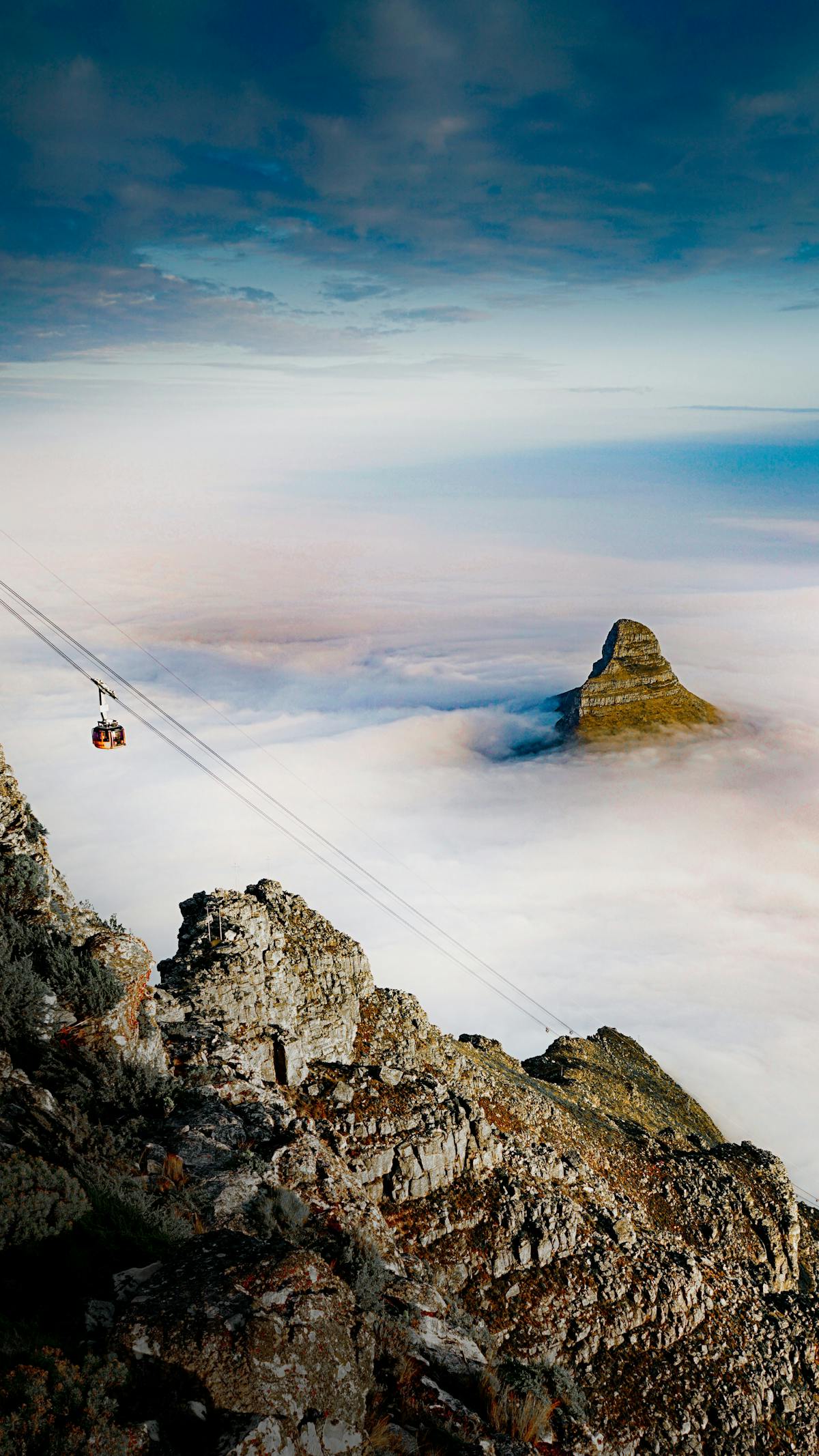
The sustainable Table Mountain Cableway is the way to go if you want to reach the 1086m-high pinnacle of Table Mountain without breaking a sweat. The views from both the revolving vehicle and the summit are spectacular. The cable cars run every 10 to 20 minutes. The entire operation has adopted numerous initiatives to stay true to its sustainable and responsible path. Table Mountain Cableway Company takes part in biodiversity conservation drives. It uses compostable crockeries, practices recycling, and is water-wise ints operation. Table Mountain Cableway has been carbon neutral since 2016. It aims to dramatically cut down its waste generation year on year despite its increasing popularity.
2. Copenhill, Denmark
Best time to visit : may to august.

Copenhagen's finest innovation in sustainability, architecture and tourism is the newly inaugurated CopenHill. CopenHill, which is partly a green power plant and partly a ski slope, draws over 300,000 tourists per year mainly owing to its landscape and the general novelty of the idea. The hybrid plant beneath CopenHill heats 60,000 homes and supplies energy to over 30,000 others. The incineration is practically pollution-free thanks to cutting-edge catalytic filtration. CopenHill, according to architect Bjarke Ingels, is not just the world's cleanest waste-to-energy power plant. It serves as a model for other communities, demonstrating that a sustainable city is not only better for the environment but also better for its residents' lives.
3. Eden Project, UK
Best time to visit : march to june and september to november.
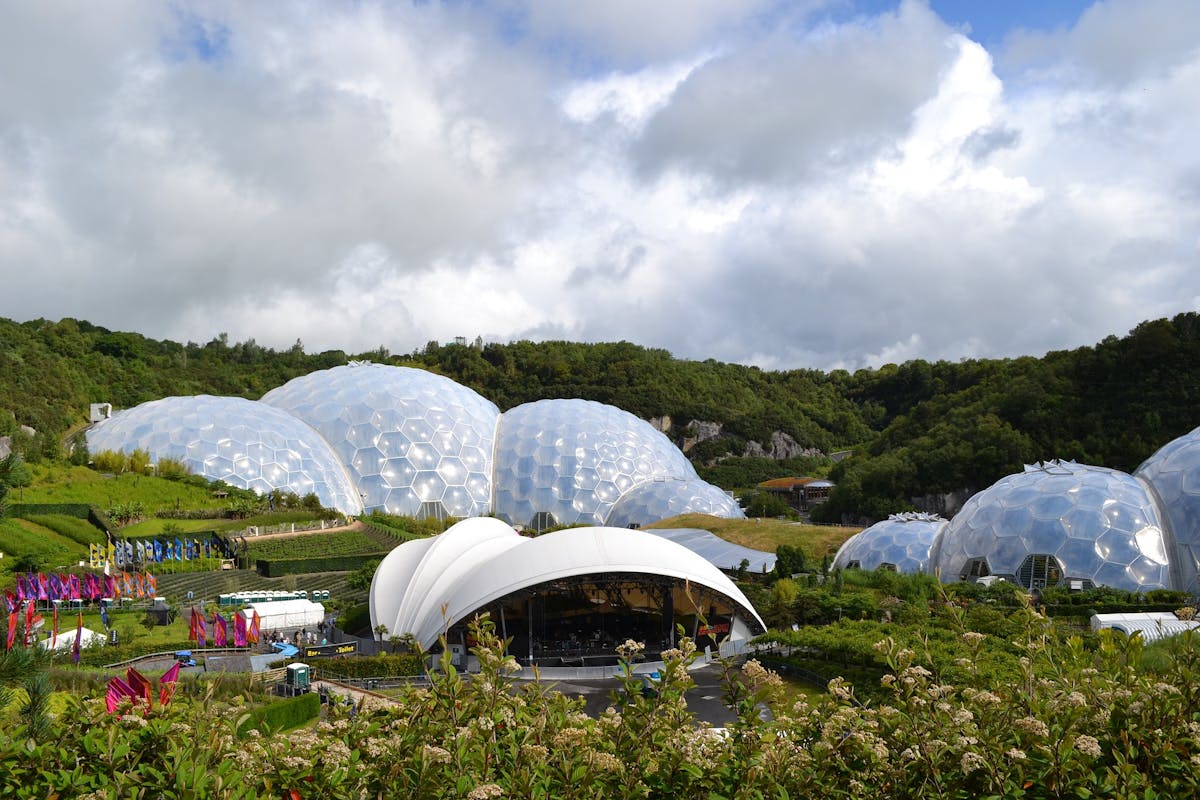
The Eden Project's massive hemispherical greenhouses, which resemble a cross between a lunar landing station and a James Bond villain's lair, have become a symbol of Cornwall's renaissance. Eden's glass-domed "biomes" created in an abandoned clay pit near St Austell, reproduce major world climate systems in microcosm, from the Amazon rainforest's lush rainforests with stinking rafflesia flowers and banana trees to the Mediterranean's olive trees, lemon orchards, and colorful flowers. Cornish plants, local wildflowers, and flora from South Africa and South Korea are among the plants in the exterior gardens. The Eden Project, which opened at the turn of the 21st century and is now considered one of Britain's modern architectural wonders, strives to examine environmental and conservation challenges and indicate the way to a cleaner, greener future for us all.
4. Jewel Changi, Singapore
Best time to visit : february to april read more: things to at jewel changi.

Singapore's urban garden game was stepped up in 2019 with an airport terminal that you would never want to leave. Jewel at Changi is a green oasis with a hedge labyrinth, a canopy bridge, and the world's highest indoor waterfall, thanks to cutting-edge sustainable technology. At Jewel Changi, energy and emissions management includes maintaining the highest levels of air quality at the airport and providing appropriate climate protection. Jewel at Changi is in line with Singapore's water security objectives, which include a change to more weather-resistant national taps. Changi Airport is a crucial infrastructure component that influences Singapore's economic development. Through worker volunteerism, corporate philanthropy, and stakeholder relationships, Jewel at Changi gives back to the communities in a variety of ways, thus rounding off its efforts towards sustainable tourism.
Recommended Jewel Changi Tickets
5. tij observatory, netherlands.

Image Courtesy: ArchDaily
Tij Observatory, modeled after a tern's egg, is a spectacular public birdwatching observatory in the Scheelhoek Nature Reserve in Stellendam, the Netherlands, meant to be as gentle on the environment as possible. The observatory, which is made of sustainable wood and coated in thatched reeds, is approached through a tunnel made of recycled bulkheads to minimize bird disturbance. In the Netherlands, Tij Observatory protects around 100,000 hectares of land. They are dedicated to the Netherlands' remaining natural resources as well as the new natural resources that will emerge in the future. Tij Observatory loves to take things a step further, therefore it works not just in the places it manages, but also in ways that are appropriate for today's Netherlands. Tij Observatory calls on all Dutch people to work together to produce, care for, and conserve new nature.
6. Climate Museum, USA
Best time to visit : all around the year.
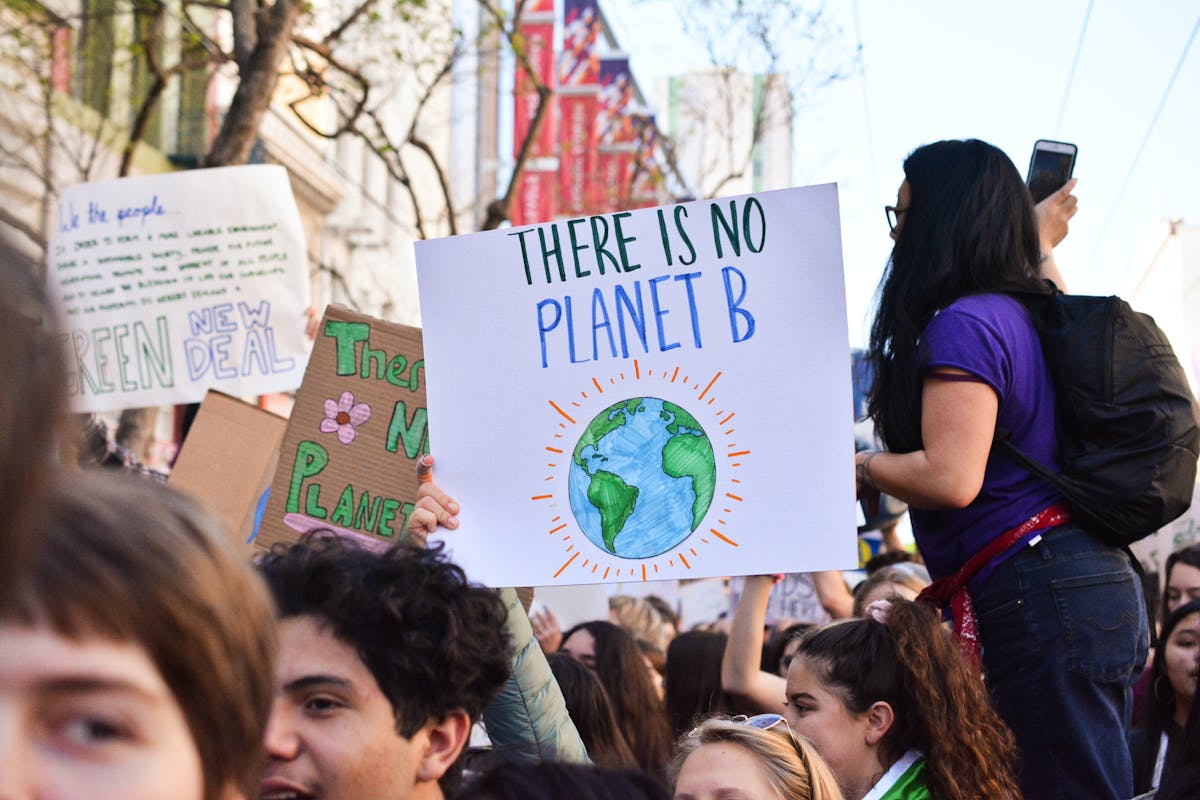
Since 2017, the Climate Museum in New York has amassed a devoted following thanks to its unique public exhibitions and events held throughout the city. Climate Signals was one of the organization's achievements. When it became possible to visit the Climate Museum from the comfort of one's own home, it marked a watershed moment. You can now explore prior programming on their YouTube channel, read the latest from staff members on their blog, volunteer online, and take action through Climate Art for Congress and Climate Ambassador Cards. The Climate Museum is fostering a climate-action culture by bringing people from all walks of life into the discussion and fostering a sense of belonging around just solutions. The Climate Museum builds on museums' appeal and trust by bringing people together to learn about solutions and join the fight for a better future, while also giving different channels into community involvement.
7. Ocean Atlas, Bahamas
Best time to visit : november to february image courtesy: andré musgrove jason decaires taylor, a british sculptor and environmental campaigner, is known for his bizarre underwater sculptures that function as artificial reefs. ocean atlas, a 60-plus-ton sculpture in nassau that depicts a little girl supporting the water's ceiling, much like the fabled greek titan who bore the load of the skies, is meant to reflect the environmental weight we are asking future generations to bear. ocean atlas, built with ph-neutral materials, offers an artificial reef for marine life to colonize and inhabit while diverting tourists away from over-exploited natural reef areas. it has attracted international media attention, which has drawn attention to a long-running oil leak from a power station refinery a few miles up the coast that has been damaging the marine environment for years., 8. the sauna in frihamnen, sweden, best time to visit : june to august.
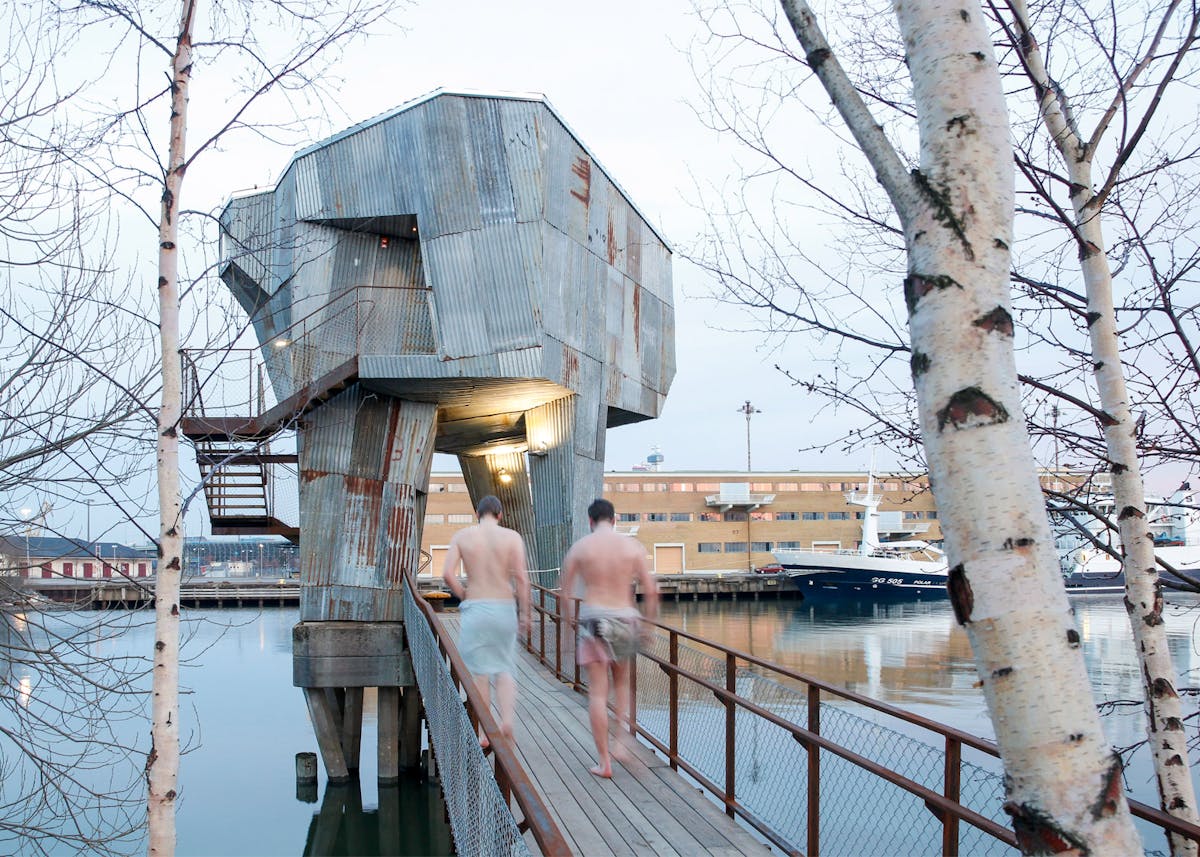
Image Courtesy: Dezeen
The Sauna in Frihamnen was built entirely from recycled materials as part of the continuous regeneration of the Gothenburg port area into an ultra-sustainable leisure destination. The sauna was designed by the German architectural company Raumlabor Berlin and is made up largely of recycled materials. The rusted steel outside of the sauna is entirely made of recycled materials, while the changing room walls are made of 12,000 recycled glass bottles. It represents how the lvstranden development company intends to develop the Gothenburg RiverCity in the future: sustainably, making the river accessible to all, and gradually allowing new places to emerge in participation and dialogue with Gothenburg residents, all while maintaining high standards of quality. The Kasper Salin Prize for greatest Swedish construction has been proposed for the free public sauna in Frihamnen, Gothenburg's harbor.
9. Byron Bay Solar Train, Australia
Best time to visit : february, march, september, and october.

The world's first solar-powered train made its inaugural ride over a picturesque 3km section of disused rail line in 2017, connecting the heart of surf resort Byron Bay to a thriving arts estate. On the wonderfully rebuilt historical train, fares are collected by a conductor instead of ticket machines. To provide a legacy rail service linking two significant Byron Bay centers, the Byron Bay Railroad Company has restored a derelict heritage train, rebuilt three kilometers of the railway line, a bridge, and conserved a stretch of an out-of-service rail route. The train is entirely powered by solar energy. The train is powered by 23% of the energy generated by solar panels on the railway shed roof feeding the onboard batteries, while the rest 77 percent is supplied into the grid via green energy provider Enova to power the local neighborhood. The train also has regenerative braking, which uses the train's braking force to charge the batteries as it slows down.
10. Azurmendi, Spain

Image Courtesy: Flickr | Dale Cruse
Azurmendi, a three-Michelin-star restaurant near Bilbao, has twice won the World's 50 Best Restaurants' sustainable restaurant accolade, proving that sustainability is fashionable. Visitors can see the on-site greenhouses and vegetable fields that supply the innovative cuisine, which is powered by solar and geothermal energy. Azurmendi is a remarkable bioclimatic building located in Larrabetzu and built into the side of a hill planted with native grapes. It is also a location that is linked to the natural environment around it, where sustainable development is coupled with cuisine as a legacy and a right of future generations. The restaurant's attempts to integrate sustainable development principles into its operations have paid off. The ratio was 84 percent in 2014, and it reached 92.33 percent in 2018.
11. Wunderland Kalkar, Germany
.jpeg?fm=pjpg&auto=compress&w=1200&crop=faces&fit=min)
Following the Chernobyl accident in 1986, German authorities opted not to start up a new multibillion-euro nuclear plant near the Dutch border. It wasn't, however, a total loss. The site was turned into Wunderland Kalkar, an entertainment park with a swing ride inside the reactor's cooling tower, in the 1990s. Wunderland Kalkar arose from the decommissioned "Schneller Brüter" nuclear power station. Hennie van der Most, a Dutchman, purchased the nuclear power station in 1995 and converted it into a hotel, meeting center, and leisure facility. Wunderland Kalkar is located just across the border between Arnhem and Nijmegen, amidst wonderfully planted gardens and ponds. The repurposing of a nuclear power plant into something that has a positive impact on the environment is a testament to the current generation’s commitment to sustainability.
12. Vena Cava, Mexico
Best time to visit : november to february.

Image Courtesy: Flickr | T.Tseng
Vena Cava bills itself as Mexico's trendiest vineyard, and it is hard to disagree when you see this all-organic Baja winery, which was built from recovered fishing boats and other repurposed materials. Even better, tastings are available every day of the week at its basement door. Phil and Eileen Gregory's appreciation for nature, the reuse of materials, and sustainability in their activities at La Villa del Valle are a personal vision and lifestyle that they enjoy sharing with their guests. The winery is situated in the center of the Guadalupe Valley, amongst a dramatic mountainous backdrop. The soil is rich in minerals, and there is a wonderful microclimate in this area, with warm days predominating and mild mornings and afternoons that receive the sea air and protect the vineyard from the cold, creating an ideal setting for grape growth and development.
13. Galapagos National Park, Ecuador
Best time to visit : december to may.

The Galapagos Conservancy advises travelers to the Galapagos Islands to travel with accredited, licensed tour operators who are dedicated to Galapagos conservation. The travel partners have corporate ideologies or are members of organizations that ensure that their operations adhere to high environmental and social standards. The Galapagos Islands were classified as the world's first UNESCO World Heritage Site in 1979, an honor given to our planet's most beautiful sites. Galapagos Islands National Park was established to conserve the islands' unique indigenous wildlife and the ocean waters surrounding them. The protected region also invests in Charles Darwin's historical scientific observations, which have helped us better understand animal life. The national park protects the world's most famous endemic species, which appear nowhere else on the planet. It is critical that the international community does everything necessary to maintain and maintain these island environments and their spectacular natural displays.
14. Wild Taiga, Finland
Best time to visit : may to september.
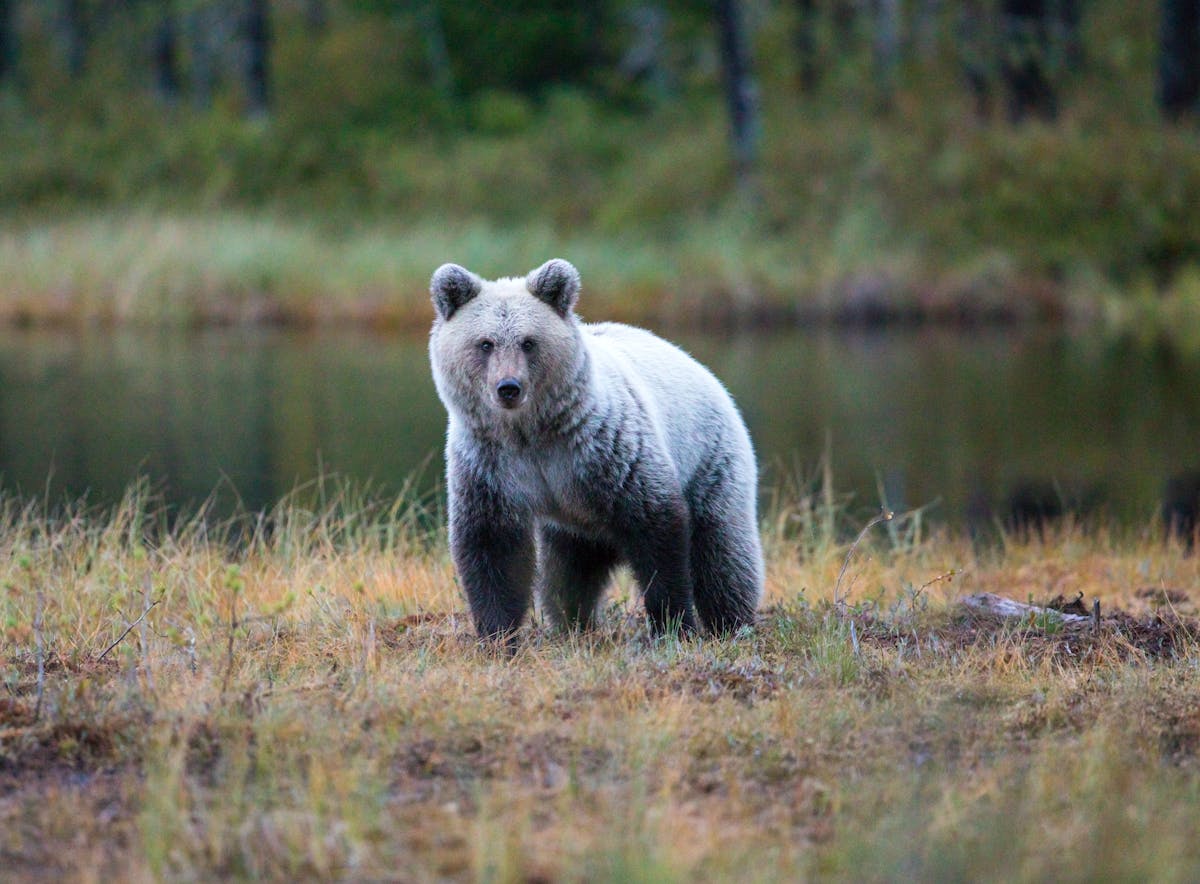
The tourism firms in Wild Taiga place high importance on responsibility. Tourism and the provision of recreational experiences are based on the natural environment, local culture, or a mixture of the two. The majority of Wild Taiga operators are small, family-owned companies dedicated to preserving the region's beautiful natural environment and rich cultural legacy. It is their hope that visitors to the region will adhere to the principles of sustainable tourism and seek out responsible experiences. Wild Taiga tourism promotes activities that do not require the use of motorized equipment as part of an environmentally sustainable tourism strategy. They provide husky safaris, horseback riding, and reindeer sled rides, among other activities, in addition to self-guided tours. Supporting local values is also part of social responsibility. Many enterprises in the Wild Taiga network operate in close collaboration with local and regional operators, and these businesses prefer to use local products. Restaurants and cafés in the region serve a wide range of locally produced cuisine made with organically farmed products.
15. Dive Azores, Portugal
Best time to visit : april to june.
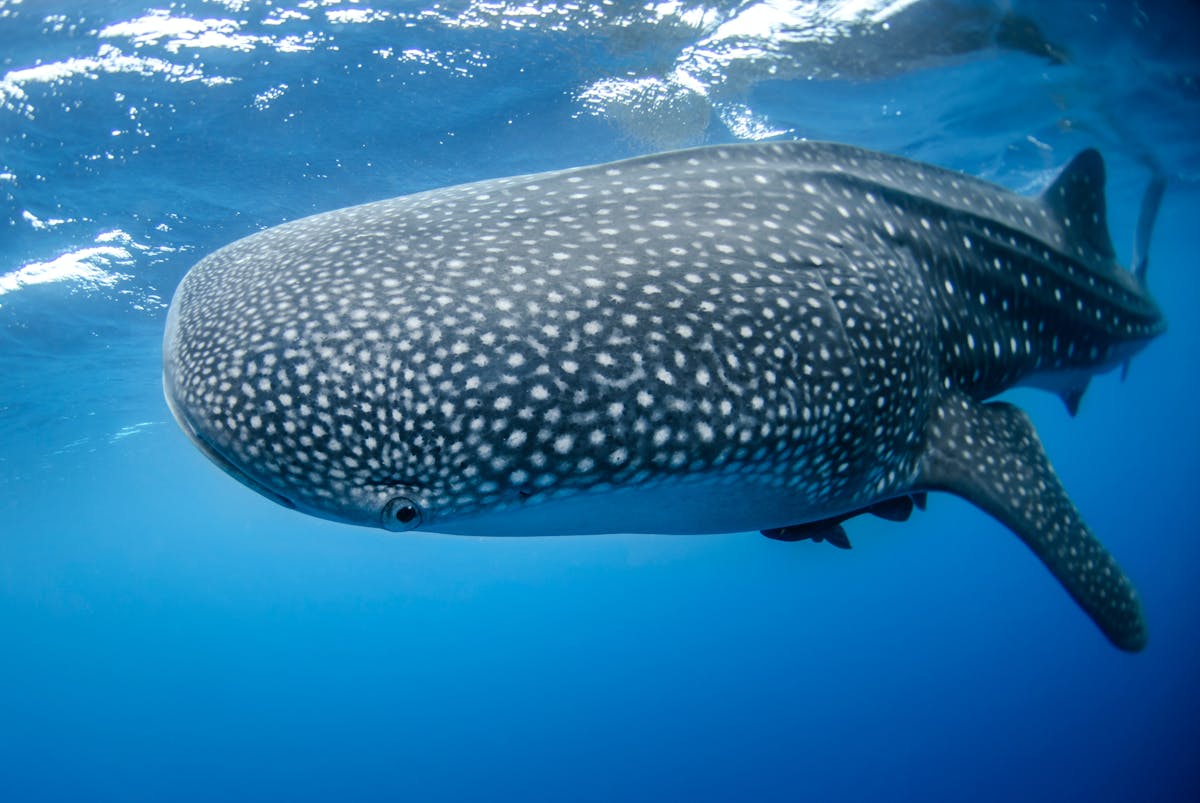
This sustainable tourist attraction is located just a four-hour flight away from the UK in the middle of the Atlantic Ocean. As activities like hiking, mountain biking, whale watching, scuba diving, and exploring volcanic landscapes are so important to the Azorean economy, the islands take conservation, both on land and at sea, very seriously, making this a wonderful spot to visit for nature enthusiasts. Renewable energy is also being actively invested in - the islands have been producing hydroelectric electricity for well over a century, there have been wind farms here since 1988, and So Miguel is currently harnessing geothermal energy. Quality Coast, a global sustainability certification initiative, examined the sustainability credentials of 1000 island and coastal vacation sites in 2013 and gave the top honor to Dive Azores.
16. Thermana Laško, Slovenia

Image Courtesy: Thermana Laško Facebook
Thermana Laško Spa resort is the ideal place to be if you want to explore the sustainable riches of Laško, Slovenia. The resort spa maintains a unified contact with the region’s natural activities by powering its facilities with renewable energy. There are numerous activities that can be accessed from Thermana Laško. Laško's brewing legacy dates back to 1825, when Franz Geyer, a mead producer, and gingerbread baker, made the first Laško beer. The passion for brewing beer was soon matched by knowledge and the byproduct will be made available for you to appreciate. At the neighborhood beekeeper, you can learn about the health and happiness benefits of bee products. In addition, the beekeepers give beekeeping presentations. Honey products are available for tasting and purchase. The ancient Romans, who were the first to discover and introduce the tradition of thermal springs to Slovenia, understood that happiness enhances our health. Thermana Laško continues the history of its thermal springs, which is backed by a wealth of experience.
What are sustainable tourist destinations?
Sustainable tourism destination is an tourist attraction or experience that ensures sustainable and green efforts for its functioning. It can be something anything from energy conservation to using recyclable raw materials to wildlife preservation.
How can I choose a sustainable tourist destination for my vacation?
While planning your itinerary, make sure to look for sustainable tourist destinations and attractions. As is the case, they may be slightly costlier, but the long-run goodness of it offsets the price.
Are all diving activities sustainable?
Diving done wrong can be unsustainable, however, if done cautiously, it is a sustainable activity. Read more about sustainable diving here .
How can I be a responsible and sustainable traveler?
Here are 15 ways you can be a green and responsible traveler
Lakshmi Menon
Born to parents bit by the wander bug, Lakshmi calls her love for travel "hereditary and habitual". Perpetually ensconced with a book in her hand and a mug of coffee in the other, she has been to over 15 countries in her 23 years of existence and is currently saving miles and money for her solo trip to Iceland. Always hustling towards the least trodden path, she has encountered some wonderful people during her escapades and if you ever meet her, she won't stop gushing about them.
Be a smart traveler
The first to know about trending destinations, travel deals, tips and all things travel.

National Geographic content straight to your inbox—sign up for our popular newsletters here

Coral reforestation helps restore desolated reefs around Landaa Giraavaru Island on Baa Atoll in the Republic of Maldives.
For travelers, sustainability is the word—but there are many definitions of it
Most people want to support sustainable tourism, even though the concept remains fuzzy.
The word “overtourism” is a relatively new term—but its novelty has not diminished the portent of its meaning: “An excessive number of tourist visits to a popular destination or attraction, resulting in damage to the local environment and historical sites and in poorer quality of life for residents,” according to the Oxford Dictionary .
As travel recovers from pandemic lows, travelers are once again experiencing the consequences of overtourism at enticing, but crowded, destinations. The UN World Tourism Organization, along with public and private sector partners, marks September 27 as World Tourism Day and uses this platform to discuss tourism’s social, political, economic, and environmental impacts.
This day highlights the importance of sustainable tourism —a framework for engaging travelers and the travel industry at large in supporting goals that include protecting the environment, addressing climate change, minimizing plastic consumption , and expanding economic development in communities affected by tourism.
Getting the facts
A National Geographic survey of 3,500 adults in the U.S. reveals strong support for sustainability. That’s the good news—but the challenge will be helping travelers take meaningful actions. According to the survey—which was conducted in 2019—while 42 percent of U.S. travelers would be willing to prioritize sustainable travel in the future, only 15 percent of these travelers are sufficiently familiar with what sustainable travel actually means.
( Learn about how to turn overtourism into sustainable global tourism .)
In the National Geographic survey, consumers most familiar with sustainable travel are young: 50 percent are 18 to 34 years old. Among travelers who understand the sustainable travel concept, 56 percent acknowledge travel has an impact on local communities and that it’s important to protect natural sites and cultural places.
The survey has informed National Geographic’s experiential travel and media businesses and sparked conversations for creating solutions around sustainability. Our travel content focuses on environmentally friendly practices, protecting cultural and natural heritage, providing social and economic benefits for local communities, and inspiring travelers to become conservation ambassadors. In short, we see every National Geographic traveler as a curious explorer who seeks to build an ethic of conserving all that makes a destination unique.
Building better practices
National Geographic Expeditions operates hundreds of trips each year, spanning all seven continents and more than 80 destinations. Rooted in the National Geographic Society ’s legacy of exploration, the company supports the Society's mission to inspire people to care about the planet by providing meaningful opportunities to explore it. Proceeds from all travel programs support the Society’s efforts to increase global understanding through exploration, education and scientific research.
National Geographic Expeditions offers a range of group travel experiences, including land expeditions, cruises, and active adventures, many of which take place around eco-lodges that are rigorously vetted for their sustainability practices.
These independent lodges incorporate innovative sustainability practices into their everyday operations, including supporting natural and cultural heritage, sourcing products regionally, and giving back to the local community.
For example, South Africa’s Grootbos Lodge launched a foundation to support the Masakhane Community Farm and Training Centre. Through this program, the lodge has given plots of land to local people who have completed the training, increasing their income and access to local, healthy foods; so far the program has benefitted more than 138 community members.
As a media brand, National Geographic encourages travelers to seek out and support properties that embrace a mission to help protect people and the environment. Not only do these accommodations make direct and meaningful impacts in their own communities, but staying at one helps educate travelers in effective ways to preserve and protect the places they visit.
Supporting sustainability
The travel industry is crucially dependent on the health of local communities, environments, and cultures. As many experts note, we need to invest in the resiliency of places affected by overtourism and climate change to achieve sustainable tourism.
( Should some of the world’s endangered places be off-limits to tourists ?)
National Geographic’s coverage stresses the importance of reducing our carbon footprint and encourages travelers to step off the beaten path and linger longer, respect cultural differences and invest in communities, reconnect with nature and support organizations that are protecting the planet. Here are 12 ways to travel sustainably , reported by our staff editors.
Storytelling can help by highlighting problems brought on by tourism and surfacing practices and technologies to mitigate negative impacts. A key goal of our storytelling mission at National Geographic Travel is to dig deeper into the topic of sustainable tourism and provide resources, practical tips, and destination advice for travelers who seek to explore the world in all its beauty—while leaving behind a lighter footprint.
FREE BONUS ISSUE
Related topics.
- SUSTAINABILITY
- SUSTAINABLE TOURISM
- ENVIRONMENT AND CONSERVATION
- PEOPLE AND CULTURE
- CLIMATE CHANGE
You May Also Like

6 tips to make your next beach trip more sustainable

Can tourism positively impact climate change in the Indian Ocean?

6 eco-conscious alpine resorts around the world

Welcome to Hydra, the Greek island that said no thanks to cars

Kit list: the essential gear to pack like a pro, from smart luggage to bag trackers
- Environment
- Paid Content

History & Culture
- History & Culture
- History Magazine
- Gory Details
- 2023 in Review
- Mind, Body, Wonder
- Terms of Use
- Privacy Policy
- Your US State Privacy Rights
- Children's Online Privacy Policy
- Interest-Based Ads
- About Nielsen Measurement
- Do Not Sell or Share My Personal Information
- Nat Geo Home
- Attend a Live Event
- Book a Trip
- Inspire Your Kids
- Shop Nat Geo
- Visit the D.C. Museum
- Learn About Our Impact
- Support Our Mission
- Advertise With Us
- Customer Service
- Renew Subscription
- Manage Your Subscription
- Work at Nat Geo
- Sign Up for Our Newsletters
- Contribute to Protect the Planet
Copyright © 1996-2015 National Geographic Society Copyright © 2015-2024 National Geographic Partners, LLC. All rights reserved
The future of tourism is sustainable and regenerative

To make tourism sustainable and even regenerative, travellers themselves must undergo a mindset shift — but that's not easy in a cost-of-living squeeze. Image: Reuters/Jonathan Ernst
.chakra .wef-1c7l3mo{-webkit-transition:all 0.15s ease-out;transition:all 0.15s ease-out;cursor:pointer;-webkit-text-decoration:none;text-decoration:none;outline:none;color:inherit;}.chakra .wef-1c7l3mo:hover,.chakra .wef-1c7l3mo[data-hover]{-webkit-text-decoration:underline;text-decoration:underline;}.chakra .wef-1c7l3mo:focus,.chakra .wef-1c7l3mo[data-focus]{box-shadow:0 0 0 3px rgba(168,203,251,0.5);} Naoko Tochibayashi
Naoko kutty.

.chakra .wef-9dduvl{margin-top:16px;margin-bottom:16px;line-height:1.388;font-size:1.25rem;}@media screen and (min-width:56.5rem){.chakra .wef-9dduvl{font-size:1.125rem;}} Explore and monitor how .chakra .wef-15eoq1r{margin-top:16px;margin-bottom:16px;line-height:1.388;font-size:1.25rem;color:#F7DB5E;}@media screen and (min-width:56.5rem){.chakra .wef-15eoq1r{font-size:1.125rem;}} Travel and Tourism is affecting economies, industries and global issues

.chakra .wef-1nk5u5d{margin-top:16px;margin-bottom:16px;line-height:1.388;color:#2846F8;font-size:1.25rem;}@media screen and (min-width:56.5rem){.chakra .wef-1nk5u5d{font-size:1.125rem;}} Get involved with our crowdsourced digital platform to deliver impact at scale
Stay up to date:, davos agenda.
Listen to the article
- Japanese domestic tourism is recovering from the shock of the pandemic but international travel is lagging.
- Travellers increasingly demand sustainable and affordable options — but those are hard to come by in a cost-of-living squeeze.
- To make sustainable and regenerative tourism a reality, travellers themselves must undergo a mindset shift.
Since the significant easing of its pandemic border control measures last October, Japan has seen a steady return of foreign tourists.
According to the Japan National Tourism Organization (JNTO), the number of visitors to Japan in July reached 2.32 million, recovering to about 80% of 2019 levels.
And Japanese people are travelling their own country more, too. According to the travel trend survey by Japan Travel Bureau(JTB), 72.5 million people in Japan traveled within their country during the summer vacation season in July and August — almost returning to pre-pandemic levels. International travel, meanwhile, was low: 1.2 million people , which is 40% of the 2019 figures.
Many people wished to travel abroad but were unable or unwilling to do so cited concerns about safety and health, the lengthy immigration procedures involved in international travel and the unfavourable exchange rates and high costs.
For the outbound recovery to gain momentum, a safe and economically enabling environment is essential.
Have you read?
3 ways hotels and tourists can work together to decarbonize travel, japan airlines' clothing rental service aims for sustainable tourism, overtourism: a challenge to sustainability.
As the influx of tourists revitalizes local economies, a growing concern is emerging: the resurgence of overtourism, where popular destinations are flooded with an excessive number of visitors. In response, Prime Minister Kishida Fumio has announced plans to develop solutions this coming autumn to combat overtourism, addressing its negative impacts on local life, including congestion, traffic jams and litter.
Even before the COVID-19 pandemic, overtourism had started to plague certain Japanese tourist spots. As Japan's tourism industry and tourist destinations hit hard by the pandemic make strides toward recovery, it essential to view these challenges as opportunities for positive change and transform tourism into something more sustainable.
Hotels across Japan are accelerating their sustainability efforts. One noteworthy example is the Tokyo Station Hotel, located within the Tokyo Station building, which is designated as a National Important Cultural Property, is implementing the " CO₂ Zero STAY " programme to virtually eliminate CO₂ emissions generated during a stay by all rooms booked through the official website.
The World Economic Forum’s Platform for Shaping the Future of Mobility works across four industries: aerospace and drones; automotive and new mobility; aviation travel and tourism; and supply chain and transport. It aims to ensure that the future of mobility is safe, clean, and inclusive.
- Through the Clean Skies for Tomorrow Coalition , more than 100 companies are working together to power global aviation with 10% sustainable aviation fuel by 2030.
- In collaboration with UNICEF, the Forum developed a charter with leading shipping, airlines and logistics to support COVAX in delivering more than 1 billion COVID-19 vaccines to vulnerable communities worldwide.
- The Road Freight Zero Project and P4G-Getting to Zero Coalition have led to outcomes demonstrating the rationale, costs and opportunities for accelerating the transition to zero emission freight.
- The Medicine from the Sky initiative is using drones to deliver vaccines and medicine to remote areas in India, completing over 300 successful trials.
- The Forum’s Target True Zero initiative is working to accelerate the deployment and scaling of zero emission aviation, leveraging electric and hydrogen flight technologies.
- In collaboration with the City of Los Angeles, Federal Aviation Administration, and NASA, the Forum developed the Principles of the Urban Sky to help adopt Urban Air Mobility in cities worldwide.
- The Forum led the development of the Space Sustainability Rating to incentivize and promote a more safe and sustainable approach to space mission management and debris mitigation in orbit.
- The Circular Cars Initiative is informing the automotive circularity policy agenda, following the endorsement from European Commission and Zero Emission Vehicle Transition Council countries, and is now invited to support China’s policy roadmap.
- The Moving India network is working with policymakers to advance electric vehicle manufacturing policies, ignite adoption of zero emission road freight vehicles, and finance the transition.
- The Urban Mobility Scorecards initiative – led by the Forum’s Global New Mobility Coalition – is bringing together mobility operators and cities to benchmark the transition to sustainable urban mobility systems.
Contact us for more information on how to get involved.
This initiative, which uses the carbon offset system, calculates and visualizes the amount of CO₂ emissions generated by guest stays and invests the equivalent amount in emissions reduction activities, thereby reducing the emissions to virtually zero. All costs are covered by the hotel itself, meaning that guests contribute to expanding forest conservation efforts and supporting renewable energy simply by staying at the hotel.
Another player in the sustainable hospitality scene is Mori Trust Hotels & Resorts. They are taking steps to preserve tourism resources by introducing eco-friendly amenities like wooden and bamboo toothbrushes and hairbrushes, as well as razors and shower caps with reduced plastic content. They are also eliminating individual packaging for soaps and amenities while charging for these items. The company is currently reassessing the amenities used in their 18 hotels nationwide, which collectively use around 16 tons of plastic each year, and aims to cut down the plastic used in amenities by over 90% by 2024.
Traveller behaviour and tourism
As hotels and other players in the tourism industry move towards a more sustainable future, it is equally crucial that travellers, who are the main drivers of tourism, follow suit and change their attitudes and behaviours.
According to the Sustainable Travel Report 2023 , which gathered insights from over 33,000 travellers across 35 countries and territories, 76% of global travellers — and 56% of Japanese travellers — express a desire to embrace more sustainable travel over the coming 12 months. On the other hand, 76% of global travellers and 75% of Japanese travellers say that the global energy crisis and rising costs are impacting their spending plans. This has led to travellers being more budget-conscious, with only 43% of global travellers and 22% of Japanese travellers willing to pay extra for certified sustainable travel experiences.
In light of this trend, offering discounts and financial incentives by tourism providers may motivate travellers to opt for sustainable travel options. Furthermore, providing more information and choices can also promote sustainable travel, since almost half of both global and Japanese travellers feel there are not enough sustainable travel options available to them.
Regenerative tourism: the future of tourism
"There's one thing we can do: actively choose sustainable hotels and resorts, and contribute to their economic impact. Guests are the key to creating a sustainable environment," says travel journalist Naoko Terada, highlighting a crucial step that we all must take.
To achieve sustainable tourism that considers environmental, social and economic impacts, it is essential to change the mindset of travellers, who must act responsibly in terms of their impact on local communities and the natural environment. The realization of a future in which regenerative tourism, a further evolution of sustainable tourism, becomes mainstream depends on changing the behaviour of both hosts and travellers.
In the World Economic Forum's Travel & Tourism Development Index 2021: Rebuilding for a Sustainable and Resilient Future , Japan took the top spot in the development index ranking.
Japan, a highly regarded tourist destination, is leading the way in the future of regenerative tourism — where the more tourists visit, the more the place changes for the better — which will have a significant impact on the transformation of the global tourism industry.
Don't miss any update on this topic
Create a free account and access your personalized content collection with our latest publications and analyses.
License and Republishing
World Economic Forum articles may be republished in accordance with the Creative Commons Attribution-NonCommercial-NoDerivatives 4.0 International Public License, and in accordance with our Terms of Use.
The views expressed in this article are those of the author alone and not the World Economic Forum.
Related topics:
The agenda .chakra .wef-n7bacu{margin-top:16px;margin-bottom:16px;line-height:1.388;font-weight:400;} weekly.
A weekly update of the most important issues driving the global agenda
.chakra .wef-1dtnjt5{display:-webkit-box;display:-webkit-flex;display:-ms-flexbox;display:flex;-webkit-align-items:center;-webkit-box-align:center;-ms-flex-align:center;align-items:center;-webkit-flex-wrap:wrap;-ms-flex-wrap:wrap;flex-wrap:wrap;} More on Davos Agenda .chakra .wef-nr1rr4{display:-webkit-inline-box;display:-webkit-inline-flex;display:-ms-inline-flexbox;display:inline-flex;white-space:normal;vertical-align:middle;text-transform:uppercase;font-size:0.75rem;border-radius:0.25rem;font-weight:700;-webkit-align-items:center;-webkit-box-align:center;-ms-flex-align:center;align-items:center;line-height:1.2;-webkit-letter-spacing:1.25px;-moz-letter-spacing:1.25px;-ms-letter-spacing:1.25px;letter-spacing:1.25px;background:none;padding:0px;color:#B3B3B3;-webkit-box-decoration-break:clone;box-decoration-break:clone;-webkit-box-decoration-break:clone;}@media screen and (min-width:37.5rem){.chakra .wef-nr1rr4{font-size:0.875rem;}}@media screen and (min-width:56.5rem){.chakra .wef-nr1rr4{font-size:1rem;}} See all

Davos 2024 Opening Film

Building trust amid uncertainty – 3 risk experts on the state of the world in 2024
Andrea Willige
March 27, 2024

Why obesity is rising and how we can live healthy lives
Shyam Bishen
March 20, 2024

Global cooperation is stalling – but new trade pacts show collaboration is still possible. Here are 6 to know about
Simon Torkington
March 15, 2024

How messages of hope, diversity and representation are being used to inspire changemakers to act
Miranda Barker
March 7, 2024

AI, leadership, and the art of persuasion – Forum podcasts you should hear this month
Robin Pomeroy
March 1, 2024

- GSTC Mission & Impacts
- GSTC History
- Market Access Program
- GSTC Board of Directors
- Assurance Panel
- Working Groups
- GSTC Sponsors
- GSTC Members
- Recruitment
- Contact GSTC
- GSTC For the Press
- Criteria Development, Feedback & Revisions
- Sustainable Tourism Glossary
- SDGs and GSTC Criteria
- GSTC Industry Criteria
- GSTC Destination Criteria
- GSTC MICE Criteria
- Criteria Translations
- GSTC-Recognized Standards for Hotels
- GSTC-Recognized Standards for Tour Operators
- GSTC-Recognized Standards for Destinations
- Recognition of Standards (for Standard Owners)
- GSTC-Committed
- Certification for Hotels
- Certification for Tour Operator
- Certification for Destination
- Accreditation for Certification Bodies
- Accredited Certification Bodies
- Stakeholder Consultations
- What is Certification? Accreditation? Recognition?
- Sustainable Tourism Training Program (STTP)
- Upcoming Courses
- Professional Certificate in Sustainable Tourism
- Professional Certificate in Sustainable Business Travel
- GSTC Trainers and Partners
- FAQs: GSTC Training Program
- Organization Membership Application
- Destination Membership Application
- Membership Policy
- Membership Categories & Fees
- Membership Payment Options
- Webinars for GSTC Members
- Members Log In
- Upcoming Webinars
- GSTC2024 Sweden, Apr 23-26
- GSTC2024 Singapore, Nov 13-16
- Past Conferences
- Destination Stewardship Report
GSTC Criteria
The global sustainability standards in travel and tourism, gstc2024 global conference, royal djurgården, stockholm, sweden - april 23-26, public consultation, revision of the gstc accreditation manual for certification of hotel/accommodation & tour operator v.4.0, what is sustainable tourism.
There are many terms that float around that may sound similar but actually refer to something distinct.
Definition of Sustainable Tourism
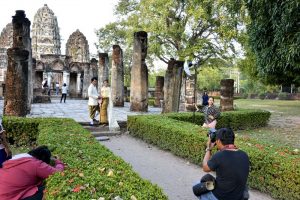
Negative impacts to a destination include economic leakage, damage to the natural environment and overcrowding to name a few.
Positive impacts to a destination include job creation, cultural heritage preservation and interpretation, wildlife preservation landscape restoration, and more.
Sustainable tourism is defined by the UN Environment Program and UN World Tourism Organization as “tourism that takes full account of its current and future economic, social and environmental impacts, addressing the needs of visitors, the industry, the environment and host communities.”
Additionally, they say that sustainable tourism “refers to the environmental, economic, and socio-cultural aspects of tourism development, and a suitable balance must be established between these three dimensions to guarantee its long-term sustainability” ( UNEP & UNWTO , 2005: 11-12. Making Tourism More Sustainable – A Guide for Policy Makers ).
Definition of Ecotourism
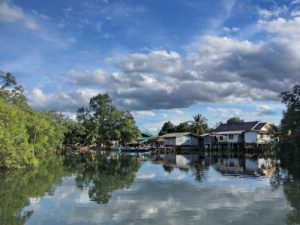
Fennell described it as such: “Ecotourism is a sustainable form of natural resource-based tourism that focuses primarily on experiencing and learning about nature, and which is ethically managed to be low-impact, non-consumptive, and locally-oriented. It typically occurs in natural areas, and should contribute to the conservation or preservation of such areas” (Fennell, 1999: 43. Ecotourism: An Introduction ).
The Mohonk Agreement (2000) , a proposal for international certification of Sustainable Tourism and Ecotourism, saw ecotourism as “sustainable tourism with a natural area focus, which benefits the environment and communities visited, and fosters environmental and cultural understanding, appreciation, and awareness.”
The ecotourism definition by the Global Ecotourism Network (GEN) : “Ecotourism is responsible travel to natural areas that conserves the environment, sustains the well-being of the local people, and creates knowledge and understanding through interpretation and education of all involved (visitors, staff and the visited).”
Definitions of Responsible Travel
Responsible Travel refers to the behavior of individual travelers aspiring to make choices according to sustainable tourism practices. The behaviors usually align with minimizing the negative impacts and maximizing positive ones when one visits a tourism destination.
Travelers that want to learn more about how to be a responsible traveler can visit the section on the GSTC website For Travelers .
Summary of the difference between Sustainable Tourism, Ecotourism, and Responsible Travel
Ecotourism is a niche segment of tourism in natural areas.
Sustainable Tourism does not refer to a specific type of tourism, rather it is an aspiration for the impacts of all forms of tourism to be sustainable for generations to come.
Responsible Travel is a term referring to the behavior and style of individual travelers. The behaviors align with making a positive impact to the destination rather than negative ones.
Sustainable Tourism and the GSTC Criteria

They are the result of a worldwide effort to develop a common language about sustainability in tourism. They are categorized in four pillars: (A) Sustainable management; (B) Socioeconomic impacts; (C) Cultural impacts; (D) Environmental impacts.
These standards were built on decades of prior work from industry experts around the globe. During the process of development, they were widely consulted in both developed and developing countries. They reflect our goal in attaining a global consensus on sustainable tourism.
The process of developing the Criteria was designed to adhere to the standards-setting code of the ISEAL Alliance. The ISEAL Alliance is the international body providing guidance for the management of sustainability standards in all sectors. That code is informed by relevant ISO standards .
Finally, the GSTC Criteria are the starting goals that businesses, governments, and destinations should achieve. Tourism destinations each have their own culture, environment, customs, and laws. Therefore, the Criteria are designed to be adapted to local conditions and supplemented by additional criteria for the specific location and activity.
There are three sets of Criteria
- GSTC Industry Criteria = relates to the sustainable management of private sector travel industry, focusing currently on Hotels and Tour Operators.
- GSTC Destination Criteria = relates to sustainable management of Tourism Destinations.
- GSTC MICE Criteria = relates to sustainable management of Venues, Event Organizers and Events & Exhibitions.
Learn more about Sustainable Tourism
Reading one article is not enough. The GSTC website offers those interested in learning more about sustainable tourism the needed resources. Make sure you visit the relevant pages for you:
- For Hotels & Accommodations
- For Tour Operators
- For Governments & Destinations
- For Corporate and Business Travel
You can also join one of the regular GSTC courses:
- Want to gain in-depth knowledge of the GSTC Criteria and understand sustainable tourism? The GSTC Sustainable Tourism course is for you.
- Engaged with corporate and business travel? The GSTC Sustainable Business Travel course is for you.
- Are you a hotelier or work in the hospitality sector? GSTC Sustainable Hotel course
GSTC Sustainable Tourism Training Schedule
✓ Gain in-depth knowledge of the GSTC Criteria, the global standard for sustainability in travel and tourism. ✓ Make informed decisions on how to implement sustainability practices for your company or destination. ✓ Get ready for developing viable and actionable sustainable tourism policies and practices for your organization
I’ve participated in the course to get a comprehensive overview of destination sustainability criteria. Much more than this, the course gave me the up-to-date analysis of current trends, and a huge number of relevant cases from the destinations, the industry networks and the service providers. I strongly recommend to attend the course.

My course facilitator and teacher (Ayako and Antje) went above and beyond to answer our questions and provide us with additional resources. The course content (the GSTC Criteria) was delivered in an understandable and organized way. Learning the GSTC Criteria and how it applies to our own projects, businesses, and destinations is integral to anyone wanting to do any kind of work in the future centered around travel. I appreciated that the course was delivered in an interactive way over Zoom, and not just something we watched on YouTube. For me, being able to interact with fellow students from around the world, was a big plus. Was well worth it, and I highly recommend the course!

This course has been very relevant and provides in-depth knowledge of GSTC criteria for sustainable practices for destinations as well as the travel industry [with] plenty of real life examples and share links to plenty of reading material throughout the course. … As we move forward during these difficult COVID times, learning our lessons on the damage to nature, it becomes all the more important for industry professionals to get trained and step up efforts to embrace sustainability in all aspects of tourism. Hence, I recommend this course to all industry professionals.

This course enables participants to connect with the GSTC team directly, over an easy to use platform and network around the world. Using real life examples and detail in each of the 4 sections of the GSTC.

The GSTC training was a great way to connect, network, and engage in mind-broadening and eye-opening discussions with others in the diverse field of sustainable tourism. I would highly recommend this as a starting point for anyone interested in the journey of regenerative and sustainable tourism.

The course was great and the on- the-go discussions added great value to keep abreast of trends from across the globe. Participants from various parts of the world brought in their experiences and made the course very interesting.

Hearing about actual destinations applying Sustainable Tourism initiatives and learning from real situations practicing Sustainable Tourism, as well as the related successes and challenges, was very informative and valuable. My favorite part was the unexpected camaraderie from and connections with the other participants. I genuinely enjoyed the online discussion, sharing of ideas, and breakout groups and, overall, meeting so many others who she a passion for Sustainable Tourism. Thank you, GSTC, for a great course!

A complete holistic approach to sustainable tourism. The comprehensive lessons given each week break down the GSTC Criteria and are paired with practical examples, international experts and ‘hands on’ online workshops. The opportunity to discuss and share insights from all the participants around the world not only contributes to my own knowledge but to also my professional network. I highly recommend this course for anyone discovering sustainable tourism.

The course is quick and handy way to immerse in the issues of Sustainability in Tourism and a great kick start in starting your own business or destination program. I could have had the course even longer and especially the live sessions were great to get to know some of the other participants and share their knowledge and experiences – best practices are the best way to get started and to get valuable information. Highly recommended!

The course was so informative and presented in an engaging & interesting way. The examples & speakers gave us a lot to think about and many tangible ways that we can make a difference in our travel business. Thank you!

This course has given me an approach to the GSTC Criteria, where the basic and complete structure to move forward on sustainable paths is visualized. The reflections generated through real examples, discussions and available material are key to better internalize what sustainability means. Ideas applicable to our business and our work area appear during the course that contribute positively to one’s reality. I will recommend this course, for its contribution to the objective, honest and constructive understanding of what sustainability is.

I can only highly recommend the course for every travel and tourism professional- it is a great motivational boost to get into action and helps me support destinations in bringing the idea of destination stewardship – an inclusive and holistic approach – alive. We do not need more and more tourists, we need sustainable tourism.

Taking the GSTC training at this point in time was extremely valuable. It gave me a sustainable tourism framework to help assess what I’ve been able to accomplish and also consider the role that sustainable experiential travel may mean as we begin to inch our way out of the world of zero tourism towards something likely new and different. One other great benefit of the training was starting to get acquainted and sharing with other participants and instructors from around the globe. These connections will be valuable for a very long time to come.

I found this online course well structured and enjoyable. The trainers are really inspiring, extremely knowledgeable about the field and very supportive. The live online sessions give a great introduction to key topics, and there are online lessons, discussion forums and reference material to deepen knowledge. I feel like I have access to so much wisdom, and it is great to be part of a global community of sustainable tourism practitioners.

Thank you GSTC for such a great course. The content was relevant, the case studies were inspiring and the course structure was spot on! I can’t wait to take my learnings and inspiration and activate it across regional destinations in Australia. Keep up the great work.

What I liked the most about this course is the well-defined structure, the opinion sharing with online classmates, and the up-to-date topics. It makes the experience much more effective and enjoyable.

Excellent course that sets the foundations for sustainable tourism practice.I was very new with sustainable tourism and now after the course I have very solid understanding and skills to apply to my job. In addition, the amazing network of professionals sharing ideas is another great tool!

This course provided me with a thorough understanding of how to implement sustainable travel practices. I will definitely integrate information from this training into my work with travel organizations and destinations to help them achieve short-term progress through a long-term strategy.

The GSTC training provides a comprehensive overview of key indicators for a holistic view of sustainable tourism. The training provided an excellent opportunity to network with other tourism professionals, and to share ideas, develop plans, and comment on sustainable tourism initiatives that are being implemented in a diverse array of locations globally. I’m grateful for the connections that I made and for the helpful feedback on ideas for improving sustainability in several operations.

Useful and inspiring! The way the course is organised with lots of practical experience from colleagues in the tourism sector is indeed the most useful and interesting part of the course, [making it easier] to approach the GSTC criteria.

The GSTC course was really great to me because it gave me an in-depth knowledge about sustainable tourism. The combination of the criteria explanation and the presentation from other experts was really great, as it gave us the know-how, lots of samples and case studies. Before joining this course, I had heard about the term sustainable tourism many times, but [was not sure] what it is all about and how we can achieve it. I am glad to have gained the bigger picture of sustainable tourism. I’m developing my village to be a community based tourism destination, and now I can adopt and apply the standard locally.

A great training program that gives the participants a thorough understanding on the sustainable management of both destinations and individual businesses. Anyone from the industry – from the business or the government side – should understand the bigger picture of the destination level management as well as the industrial level so that both public and private sectors can work together for a more sustainable tourism industry.

The GSTC Sustainable Tourism Training Program provided an up-to-date perspective and holistic approach on the topic. I really enjoyed taking part in the group discussions and hearing about the realities of other destinations and their challenges.

I think the training was very useful and gave me many insights that I will use in my daily work to develop more sustainable tourism. The training class was also a good group for networking.

The Global Sustainable Tourism Council (GSTC) is the most widely recognized institution for offering sustainability courses for tourism professionals.

This is a one-of-a-kind course that provides the tools in getting you started. Not to mention, you’re also collaborating with people and organizations across the globe facing similar challenges. The feedback from fellow students was invaluable and honestly, what better way to tackle some big challenges related to the environment than with people from different countries and backgrounds. I’d take this course again just for those connections!

The [GSTC course] has been a remarkable learning experience and a great introduction to sustainable tourism. The combination of online resources, discussion forums, weekly live events with guest presenters provides a deeper understanding and useful tools in sustainable tourism. The trainers have incredible expertise in both tourism and sustainability and share their knowledge and passion about current sustainability practices. I would highly recommend this course to everyone involved in the tourism industry or have a interest in sustainable tourism.
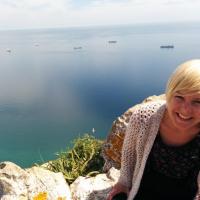
An excellent programme run by well qualified professional staff and trainers. The guest speakers were world class and materials industry leading. A definite must for any tourism professional who is serious about making sustainable impacts for the betterment of our industry.

Amazing learning experience. Exceeded my expectations by far. Excellently organized and facilitated. Great dynamics in discussions with course participants – so much to learn from. Highly valuable best practices and interactive modules really made the best learning experience I had until now! It really motivated and inspired me to continue on the road of global sustainable tourism.

The GSTC Sustainable Tourism Training gave me the tools and network to be able to work for a more sustainable tourism sector in the area where I’m based (South Sweden). The structure with the four principles makes it easy to follow and to discuss also outside the GSTC world. The examples from the other participants were great, and we will continue sharing good and bad examples from destinations all over the world.

To work on sustainability is a never-ending story and can be overwhelming at times. The GSTC training supports a structured approach toward continuous improvement. It provides applicable tools to evaluate our sustainability performance and guidance for setting long-term strategies. It allows you to break down this massive task into achievable working packages.

The GSTC training was a great first touch point for me into the world of sustainable tourism and destination management. I loved hearing case studies from around the world and real life examples on how the GSTC criteria can make a difference. The course has enabled me to start building on these criteria within my job.

The training has enable me to go through all the GSTC Criteria thoroughly with better knowledge of sustainable tourism standard and practices. It will be useful as basic guidelines for the Foundation to use these Criteria, as the destination wants to embark in becoming a sustainable tourism destination, aiming to become GSTC-Certified.

I would definitely recommend GSTC training to absolutely everyone in the tourism industry. The entire [GSTC] framework is extremely useful and important – a framework of values and ideas that is evolving, and that is meant for us a roadmap to make things better for people and companies that may be starting from different points in the journey towards sustainability.

The quality of this training was really first class; materials, presentations, trainer support, resources and discussions. The forum helped keep everything relevant and up to date, and I also liked the format of the live events. All guest presenters were excellent; I liked that they were sharing real life experiences and not just theoretical examples. From each and every live presentation I gained ideas, reinforcements to my own experiences and enthusiasm for what I and my colleagues are doing in our own part of the world.

The STTP programme has been a good introduction to the principles of sustainable tourism. It was a good mix of presentations and cases of sustainable tourism in real-life, insights from experts from various countries and across tourism sectors and explanation of key GSTC criteria. Participants were encouraged to share their experiences and observations through discussion forums and presentations, which made the sessions more lively. The final exam is recommended for those who wish to test their ability to put these principles to practice. I highly recommend this course to tourism industry professionals wishing to incorporate sustainable tourism management at work.

The GSTC training provided me with a deep understanding of the criteria. My fellow classmates were industry experts in various sectors from around the world, bringing the criteria to life with valuable examples/discussions of how they have implemented the very practices we were learning.

My first impression was the organization, it was perfect regarding the admin efforts and the learning tools. The course materials were really useful, as well as the live sessions from which I gained a deep understanding and experience from the other participants. I really want to have the chance to thank all the team who was involved, and of course I would recommend people working in the tourism industry to join this course

The training gave me a clear understanding of the challenges we face and the actions to take to make sustainability effective, [covering] each of the main areas in a systematic way with enough technical detail for those who needed it, without losing the less technical trainees (like myself) who needed to understand the broad overview of sustainable tourism practices

The overview of standards, coupled with best practice and real world examples has been very beneficial for my work in destination management and responsible tourism development. The ability to meet likeminded industry colleagues, who are working in this arena was also highly valuable.

Share This Story, Choose Your Platform!
Related posts.
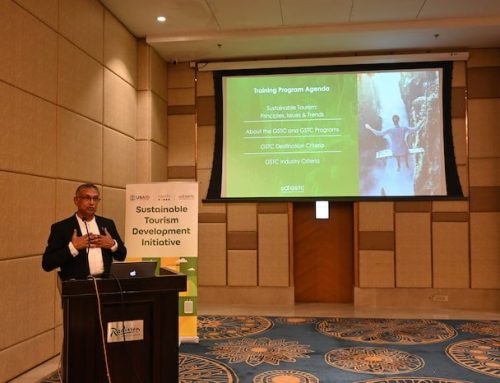
The GSTC Hotel Sustainability Training for Industry Professionals in India, in partnership with Agoda & USAID, concluded successfully
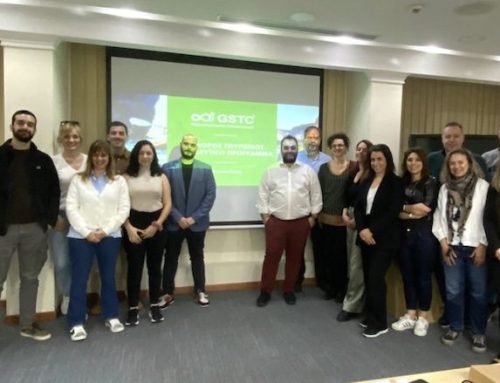
The GSTC Sustainable Tourism Training in Greece concluded successfully
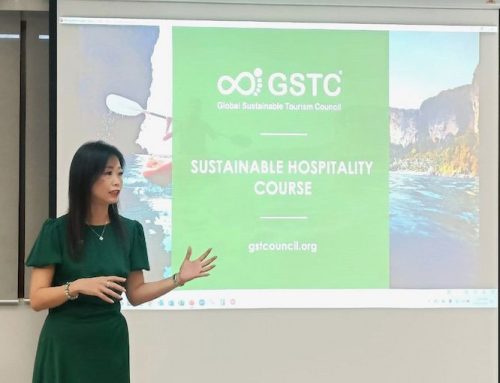
GSTC Sustainable Hospitality Course at Ascott Centre for Excellence in Singapore concluded successfully
- The T4SDG Platform

- What are the SDGs
- Tourism and SDGs
- Companies CSR and SDGs
- Tourism in National SDG Strategies
- TIPs Toolkit
- SDGs Dashboard
- Tourism for SDGs
- CSR & Sustainable Development Goals
- Tourism in National SDG strategies
- G20 Tourism and SDGs Dashboard
Part II Snapshot - SDG 16
Each chapter in Part II of TIPs is dedicated to one SDG. In the chapter for SDG 16, users will be introduced to selected targets and potential indicators (note: Indicators are non-exhaustive and adaptable) for tourism projects that can promote, justice and strong institutions.
- Achieving the SDGs through tourism: Toolkit of Indicators for Projects (TIPs)
- SDG 16 Peace Justice & Strong Institutions
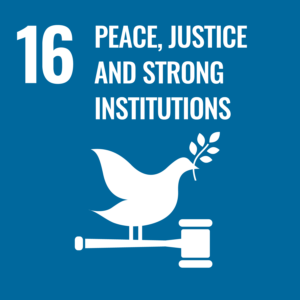
While tourism alone cannot prevent or solve conflicts, it can be a complementary tool for promoting peace and stability by promoting cultural exchange and supporting the establishment of institutions and access to judiciary systems that promote peace and justice. It is crucial to have well-planned and coordinated efforts between governments, tourism stakeholders, and communities to ensure that the benefits of tourism are equitably distributed, and that the sector operates in a responsible, inclusive, and sustainable manner. By doing so, tourism can help to promote SDG 16 and contribute to long-term peace and stability in societies.
There are nine targets within SDG 16 that are deemed to have a stronger and direct link for tourism to promote peaceful and inclusive societies for sustainable development, provide access to justice for all and build effective, accountable, and inclusive institutions at all levels. These targets have been selected to base the potential project indicators.
TARGET 16.1
SIGNIFICANTLY REDUCE ALL FORMS OF VIOLENCE AND RELATED DEATH RATES EVERYWHERE
Target 16.1 calls for a reduction in violence everywhere. Tourism can contribute to this target by ensuring surveillance, security, and the careful development of tourist areas. Categorization as a “safe destination” is a key factor influencing the image or brand, thus the overall sustainability of a destination. The most significant impact of crime on a tourist destination is the drastic reduction in tourist demand, hereby hampering potential economic benefits for the local economy, which, again, contributes to the worsening of the situation onsite.
Potential indicators in this target are grouped by the following Theme and sub-theme:
Violence and harassment / Violent crimes
Violence and harassment / Harassment
TARGET 16.2
END ABUSE, EXPLOITATION, TRAFFICKING, AND ALL FORMS OF VIOLENCE AGAINST AND TORTURE OF CHILDREN FOR MANY FOREST-RICH TROPICAL COUNTRIES.
Tourism can play an active role in preventing child abuse, human trafficking and torture by developing and adopting policies and programmes that support local and international actions against child abuse. Several factors make the tourism sector especially vulnerable to human trafficking and modern slavery compared to other sectors, such as the frequent changeover of clients in hotels and airports, increasing automation of operations, the common practice of using subcontractors for different tasks such as construction, maintenance, security or cleaning. The commercial sexual exploitation of children, including child sex tourism, is a manifestation of labour exploitation and included in the International Labour Organisation’s (ILO) efforts to eliminate the worst forms of child labour. Therefore, tourism stakeholders by all accounts should actively develop strategies to protect children and minimize the risk of abuse.
Potential indicators in this target are grouped by the following Theme and sub-theme:
Legal frameworks, policies and rule of law / Child protection
Legal frameworks, policies and rule of law / Tourism policies and strategies
Education and training / Capacity building
TARGET 16.3
PROMOTE THE RULE OF LAW AT THE NATIONAL AND INTERNATIONAL LEVELS AND ENSURE EQUAL ACCESS TO JUSTICE FOR ALL
The focus is on the access to justice institutions and dispute resolution mechanisms (both formal and informal). It is broadly concerned with the ability of people to defend and enforce their rights and obtain just resolution of justiciable problems in compliance with human rights standards; if necessary, through impartial formal or informal institutions of justice180 and with appropriate legal support.181 Tourism can be a respected tool for personal development andsocial transformation. Sociologically and ecologically positive tourism development can create better futures for all stakeholders. Tourism legislations are important as a means for governments, and tourism officials to ensure that there is legal standing whenever the rule of law is under threat.
Potential indicators in this target are grouped by the following Theme and sub-theme:
Legal frameworks, policies and rule of law / Accountability, compliance and transparency
Legal frameworks, policies and rule of law / Access to justice
TARGET 16.4
BY 2030, SIGNIFICANTLY REDUCE ILLICIT FINANCIAL AND ARMS FLOWS, STRENGTHEN THE RECOVERY AND RETURN OF STOLEN ASSETS AND COMBAT ALL FORMS OF ORGANIZED CRIME.
Target 16.4 seeks to combat organized crime and illicit financial and arms flows. By principle, the tourism sector should altogether condemn any form of criminal activity. Tourism actors, including tourists, should be aware of the types of illicit activities that they may be exposed to and which directly or indirectly fund organized crime groups.
Tourists can reduce the demand for illicit products and services, by making ethical consumer choices and informed decisions, helping to put a halt to many crimes and violations such as human trafficking, wildlife crime and trafficking in illicit drugs, counterfeit goods and cultural artefacts. In 2014, UNWTO, UNODC and UNESCO launched an anti-trafficking campaign – “Your Actions Count – Be a Responsible Traveller” – in line with the UN’s goal of combating organized crime and promoting, through the UNWTO Global Code of Ethics for Tourism, equitable, responsible and sustainable tourism.
Potential indicators in this target are grouped by the following Theme and sub-theme :
Tourism value chain / Tourism operations
Education and training / Awareness raising
TARGET 16.5
SUBSTANTIALLY REDUCE CORRUPTION AND BRIBERY IN ALL THEIR FORMS
Target 16.5 sets out to substantially reduce corruption and bribery. In this regard, and since corruption is an obstacle for tourism development, if a country practices bribery and fraudulent business practices, the damage it brings to the country’s social and cultural image can impede its tourism competitiveness. It leads to bureaucratic delays and encourages administrative inefficiency. The fight against corruption needs to be integrated into strategies for sustainable tourism. Where existing structures facilitate corrupt behaviour, there is a need to improve monitoring, transparency and accountability. Corruption and bribery are practices that may affect any socioeconomic sector, but tourism may be more exposed to such situations as it is a sector that requires a large scale of infrastructure development or business registration.
Legal frameworks, policies and rule of law / Accountability, compliance and transparency
TARGET 16.6
DEVELOP EFFECTIVE, ACCOUNTABLE AND TRANSPARENT INSTITUTIONS AT ALL LEVELS
Target 16.6 aims to develop effective, accountable and transparent institutions. Transparency serves to achieve accountability, which means that authorities can be held responsible for their actions. Effective tourism calls for reliable and accountable reporting systems; this includes transparency and access to expenditure made by tourism companies. Having checks and balances within a tourism institution is crucial. Therefore, this target is critical for tourism to achieve the SDGs as sustainable tourism needs clear and effective governance
Legal frameworks, policies and rule of law / Sustainability reports
TARGET 16.7
ENSURE RESPONSIVE, INCLUSIVE, PARTICIPATORY AND REPRESENTATIVE DECISION-MAKING AT ALL LEVELS
Tourism benefits from a representative decision-making system that is inclusive and responsive to ensure a fair and equitable environment for tourism to flourish. The need to be responsive, inclusive, participatory and representative in decision making in the tourism industry would increase the general level of the sector’s effectiveness and accountability. Having all parties (men, women, vulnerable groups, etc.) involved in decision-making broadens perspectives, increases creativity and innovation, diversifies the pool of talents and competences and improves the process of decision making.
Inclusion / Equality and inclusivity
TARGET 16.A
STRENGTHEN RELEVANT NATIONAL INSTITUTIONS, INCLUDING THROUGH INTERNATIONAL COOPERATION, FOR BUILDING CAPACITY AT ALL LEVELS, IN PARTICULAR IN DEVELOPING COUNTRIES, TO PREVENT VIOLENCE AND COMBAT TERRORISM AND CRIME
Target 16.a recognizes the need to strengthen the capacities of national institutions, including tourism authorities, to prevent violence and combat terrorism and crime. Security threats related to urban and organized crime endanger tourism and its sustainable development, thus having a negative impact on the economic and social development of communities as well. Tourism enables the participation of civil rights organizations in international human rights discussions to raise concerns or challenges on violation. Tourism activities can, and should, be aligned with national and international efforts to combat violence, terrorism and crime and ensure that tourism projects can contribute to strengthen existing programmes in combating crime. The strengthening and coordination of crime prevention policies and effective responses can help to efficiently address security-related threats affecting citizens and tourists.
Potential indicators in this target are grouped by the following Theme and sub-theme:
Legal frameworks, policies and rule of law / Tourism destination security
TARGET 16.B
PROMOTE AND ENFORCE NON-DISCRIMINATORY LAWS AND POLICIES FOR SUSTAINABLE DEVELOPMENT
Tourism can contribute to this target by providing social standards that can strengthen the enforcement of non-discriminatory laws. This could include certification schemes, network platforms, businesses and host countries that adhere to non-discrimination laws. Tourism’s role in promoting understanding and ethical values common to humanity with an attitude of tolerance and respect for the diversity of religion, race, ability, size, gender and age aligns well with the set target.

12 Essential Sustainable Tourism Tips
Last Updated on August 24, 2023
These 12 essential sustainable tourism tips will help you create a positive impact while traveling.
There are a lot of similarities between the terms we see used to describe environmentally friendly travel. There’s eco travel and eco tourism, and there’s zero waste travel, and there’s also green travel.
I like to use the term sustainable travel because it does a good job of expanding the concept of sustainability beyond just environmental issues.
What is Sustainable Tourism?
1. minimize flying as much as possible. , 2. travel slowly for sustainable tourism., 3. pack zero waste and reusable products., 4. bring a water filtration system. , 5. support and shop at local businesses. , 6. support local tourism operators., 7. practice responsible wildlife tourism., 8. eat as the locals do., 9. minimize waste in hotels., 10. walk, cycle, and use public transit., 11. avoid contributing to overtourism., 12. continue learning about sustainable tourism and advocating, final thoughts: sustainable tourism tips .
Sustainable tourism is a model for ensuring that nature, culture and history is preserved. This is becoming increasingly important with more and more tourists traveling every year.
With sustainable tourism, we can take full account of the current and future economic, social and environmental impacts of travel. And, address the needs of visitors, the industry, the environment and host communities.
Sustainable tourism is important , because with a sustainable approach to tourism, we can reduce the effects of overtourism , support local and Indigenous communities , protect natural resources and wildlife , and become a more responsible traveler .
When talking about sustainability, I think it is important to remember that around the globe, sustainability might look different. Sustainable solutions we are pursuing here in Canada, for example, might not make sense in other countries.
For example, here in Canada we have lots of access to foods that support vegan and vegetarian diets – but that isn’t the case all over the globe. While traveling, I think it’s important to keep this in mind and be empathetic to diversified approaches to sustainability.
It is always up to a local community to decide what is best for them: their culture, nature, wildlife and more.
12 Sustainable Tourism Tips
Are you ready to become a more sustainable tourist? Read on for 12 essential sustainable tourism tips!
Flights add a significant amount of planet-warming gases to the atmosphere. For example, taking one return flight can generate more CO2 than citizens of some countries produce in an entire year, which means your carbon footprint goes up exponentially every time you fly.
Air travel is so destructive, that some people actually opt to quit flying entirely. I interviewed sustainable travel blogger Evelina Utterdahl about her choice to quit flying, and the #nofly movement that has started in Sweden. You can listen to that interview right here!
Of course, for many of us it is not realistic to cut out flying entirely. Some of us may have family abroad, or be required to fly for work. If you live in a country like Canada or Australia, visiting another country might not be possible without a flight (or a multi day road trip).
Immigrants must fly to visit home, and some refugees rely on flights to escape conflict zones. Our best approach to sustainable tourism when it comes to flying, is to reduce how much we fly, as much as possible.
Here are some ways that you can reduce your air travel carbon footprint:
- Most emissions are released during takeoff and landing. You can reduce the carbon impact of your flight by booking a direct flight rather than a flight that includes connections. The less you takeoff and land, the better!
- Travel overland rather than booking a flight, particularly when traveling short distances. In some cases, flights are a big time saver, or they’re getting you across an ocean. But wherever possible, take that train (or bus!) instead of the plane!
- Fly economy class. Business class fliers leave a far larger carbon footprint , so by opting for economy you can minimize your impact when you do fly.
- You can also neutralize your carbon footprint by paying carbon offsets. This means funding projects that remove carbon emissions like reforestation, farm power and landfill gas capture. Make it a practice to donate, every time you fly.
Rather than hopping from one place or city to another every 1 to 3 days, spend as long as possible in a place. Spending more time in a place enables tourists to better connect with the destinations they visit. Staying longer means you can get to know the culture and people better.
Tourists can invest more of their dollars in that region, which benefits the local community and economy. And, traveling slowly has environmental benefits – it results in less overland and air travel, which means less CO2 emissions.
The goal of a zero waste product is to reduce the amount of waste that goes to landfills. As more and more zero waste products become available, zero waste is becoming an accessible way to reduce your environmental impact. In recent years, I’ve introduced zero waste products into my life at home, but also into my travel habits.
These are my favorite zero waste items to bring traveling, that help with sustainable tourism:
- Canvas bags, reusable cutlery, and reusable food storage containers. By bringing these items along, I can refuse single use items that I might come across while shopping or dining out. I have canvas bags to use instead of accepting plastic bags, and reusable cutlery for takeout. I like to bring some containers for random things, like leftover food I might like to save.
- Zero waste toiletries. I have always been all about the basics when it comes to toiletries. When traveling, I bring a no waste shampoo bar (I like the ones from Lush!), toothpaste tablets (I love the ones from Canadian company Oxygenate !), and a bamboo toothbrush.
One thing to note? Zero waste offers us a holistic solution to the problem of waste that we as individuals produce. But, the problem of waste going to landfills is much bigger than individuals, it has a lot to do with manufacturing.
The first time I traveled across India I bought tons of bottled water because it was the simplest way to access safe drinking water. Over the course of that trip an immense amount of plastic was tossed out – just from water bottles.
I was cognizant of it because while at home, I never buy bottled water. Instead, I always carry a small reusable bottle that I can refill in water taps throughout my day. After that trip, I decided it was time to give up bottled water while traveling, too. The solution? A portable water filtration system. Filtering your own water is a sustainable tourism practice because it will reduce how much plastic waste you generate.
There are tons of systems to choose from that suit different needs, but all systems have the same function: they filter contaminants out of water, making it safe to drink. There are tons of options to choose from, Lifestraw is a popular one, especially for hiking and camping. After comparing options, I opted for Grayl.
Grayl bottles come in two parts: A cup and a filter. To make water safe to drink, you’ll remove the filter and fill the cup with water from anywhere: a river, a lake, a tap, even rainwater. Once the cup is filled, you insert the fitted filter and slowly push it down. As you push the filter down into the cup, the water is filtered through. Pathogens, chemicals, and heavy metals are removed, and in as little as 15 seconds, tada! Safe drinking water.
So far, I’ve used my Grayl bottle for camping trips around Ontario – like to Algonquin Park and Point Pelee National Park . As soon as it’s safe to travel internationally again (post pandemic!) I will be bringing this bottle along to filter all my water – specifically when I travel to countries that don’t have safe tap water.
One of the most important sustainable tourism tips is to support local people and their communities by investing your dollars in them rather than the corporate companies. This sustainable tourism practice means skipping the Starbucks and opting for a local cafe instead!
By putting your dollars towards local hotels, restaurants, cafes, and other businesses, you can help ensure that the locals in the place you are visiting are directly benefiting from tourism. This helps keep tourism sustainable for a community long term.
A few ways to support local communities include buying directly from markets and artisan shops, eating in small restaurants, selecting locally owned and operated tour companies and staying in locally owned hotels and hostels.
And souvenirs? Many souvenirs are imported from elsewhere. Keep an eye out for souvenirs that appear to be mass produced, and instead opt for souvenirs from local markets or artisans.
If you’re ever unsure about how local a restaurant or hotel is, do a bit of research. Oftentimes online reviews will reveal who is operating or who owns the business, and that’s a great clue to whether it’s local or not. You can also look for clues on the business’s website, or simply ask!
Many global tour operators are actively working toward more sustainable tourism practices. There are eco-operators that take steps to minimize their environmental impact, and many tour operators are working toward hiring local guides and supporting local business as much as possible.
When booking group travel or tours, do a bit of research to see what kind of support the company you’re looking at is giving to the local community. Look at whether their guides are local to the destination you’re visiting, look at whether other staff are local, and look at if they support local restaurants and hotels rather than chains.
When possible, you can also choose to hire a guide once you’ve arrived at your destination. For example, when we traveled to Guatemala to do the Acatenango hike (which gives you views of an erupting volcano !) we didn’t book our guide until we’d arrived in Antigua. Rather than booking a global tour company for our hike, we asked in our hostel to be connected with a local guide.
Sustainable tourism means protecting all aspects of a community and environment, including their wildlife. Observing wildlife while traveling is very rewarding, but to do it responsibly you’ll want to stick to observational experiences only.
When a tour, safari, or sanctuary allows you to interact with wildlife, it’s important to remember that you’re interacting with an animal that has been trained to interact with you. It’s a bad sign if you’re allowed to touch, ride, or hold a wild animal.
Instead, opt for tours and experiences that are observation-based and don’t disturb any wildlife. Seeing wildlife this way is truly magical, because you get to see beautiful animals as they are in their natural habitat.
The best line of defence when it comes to wildlife tourism is to always do your research, and do it really well. For example, if there’s an elephant sanctuary you want to visit, look at whether or not they allow visitors to touch, feed, or ride the elephants. You can also look at reviews for that sanctuary to learn what other tourists have seen there. If they’ve witnessed maltreatment, it’ll likely be mentioned in the review.
For more on responsible wildlife tourism, read Your Guide to Responsible Wildlife Tourism
My severe food allergies often means I can’t safely eat local foods when I travel, and this always disappoints me. Trying local cuisine is such an exciting part of traveling! And eating as the locals do is also a great way to support sustainable tourism.
This means avoiding big food chains and restaurants, and avoiding imported food and grocery. Instead, shop in local markets for produce, and pop into small restaurants for meals. By doing this, you are supporting the local food chain and you are supporting the local economy.
I also find that eating local is an opportunity to interact with the local community. While in Hampi, India , my partner and I ate at the same little restaurant every single day. Over the course of the week that we spent there, we developed rapport with the guys who worked the dinner shift.
We chatted with them every evening, sharing what we’d been up to all day. They would tell us about their day, and we learned tons about their lives. By the end of the week we were friends!
Hotel rooms tend to come with many single use items. One way to reduce your impact while traveling is to avoid using these products, and behave in your hotel room like you would at home.
Here are sustainable tourism tips for staying in hotels:
- Bring your own toiletries and toothbrush. This way you won’t need to use the tiny hotel bottles of shampoo, lotion, and other items that are offered. If you can, avoid drinking bottled water that is provided.
- Hang up your towels so that they can be reused rather than replaced daily.
- When you leave your room, remember to turn off lights, air conditioning, the television and other appliances.
- Leave the “do not disturb” sign on your hotel door knob so that hotel staff know not to wash linens and towels every day.
Renting bikes, walking, and taking public transport when you’re traveling does more than just reduce your carbon footprint. It’s a great way to see a new place while practicing sustainable tourism!
I love getting around on foot and on public transit when I’m visiting a new place because it creates an opportunity to get outside more, exercise, and save on your travel budget.
For example, when my partner and I visited Mexico City we made a point of taking the subway system and local busses to get around. Even though Uber trips are super affordable in Mexico City, we found that taking public transport was more fun because we got to experience the city in a local way. We even opted to take public transport for our day trip to the famous Pyramids of Teotihuacan !
Overtourism is when there’s too many tourists in a place and it overwhelms local communities. It is an unsustainable issue that can contribute to displacement of local residents, damage to natural environments, it can endanger protected species, and it can sometimes threaten the local way of life.
You can avoid contributing to overtourism by traveling to places that are less mainstream or less popular. For example, instead of going to the Thai islands, I opted to visit the Cambodian islands.
Of course, some destinations become popular for a reason, so of course not everyone will be willing to skip spots on their bucket list entirely. If that’s the case, consider second city tourism. All this means is visiting a second, less popular place after the bucket list place.
If you visit Amsterdam , for example, which is a city that has publicly acknowledged they are struggling with overtourism, you can counter that impact by visiting a less popular city as well, like Leiden or Den Hague. By doing this, you spread your tourism dollars further and also help to build up the reputation of other Dutch destinations.
Want to read more about how overtourism happens, it’s impact, and how to avoid it? Read How to Avoid Contributing to Overtourism
It’s important to emphasize that responsible and sustainable travel is personal. Some of the above suggestions for traveling more sustainably might suit you, and some might not. And that’s okay. Find a way to approach sustainable tourism that works for you, and continue to be open to learning and to change.
I have found that my sustainable tourism practices are constantly evolving as I learn more. When I compare the way I travel now to how I traveled even just two years ago, I’ve become much more aware of my impact, and much better at mitigating it (and finding ways to contribute to the communities I visit).
And, I’m finding that this helps me feel much more connected to the places that I visit – some call this deep travel. The other thing to note is that sustainable models of tourism depend on more than just the actions of individual travelers.
Airlines, tourism boards, local governments, hotel owners, business owners and other parts of the tourism industry have a part to play in it as well. As individual tourists, we can take actions ourselves, but industry solutions are just as important.
As we’ve learned, sustainable tourism is important . As travelers, we can all play a small part in supporting it. There are simple things that all of us can do on our travels to help reduce our impact.
The easiest way to start? Book the most sustainable options for flights, hotels, tour operators, etc. From there, minimize your short haul flights, travel lightly, pack zero-waste and reusable toiletries, and use a water filtration system to avoid buying bottled water.
More on responsible travel:
How to Avoid Contributing to Overtourism
Your guide to unpacking travel privilege.
- Your Guide to Responsible Wildlife Tourism
- What is Second City Tourism?
Erin has been traveling for over a decade, both solo, and with her partner. She’s now traveled to countries across 6 continents, and has lived in 2 countries abroad. Erin also hosts the travel podcast, Curious Tourism , where she interviews travel industry thought leaders and experts about responsible tourism. Learn more about Erin, and get in touch with her, here .
Related Posts
Your guide to responsible budget travel, avoid overtourism: visit these underrated places instead, 6 thoughts on “12 essential sustainable tourism tips”.
Those are great tips to encourage sustainable travel. I always prefer staying in a city for at least five to six days to get a real feel for it. I also like to visit the smaller, local restaurants instead of the big chains!
These are some great tips! Last year I made a lot of switches of home products to sustainable and zero-waste alternatives, and my goal for 2021 and beyond is to work on making my travels more sustainable! Slow travel is a big focus for me because I’m so guilty of rushing around and not taking enough time to appreciate the place I’m visiting. Also, supporting local businesses is so important! Especially after the impact of the pandemic. Thanks for sharing your top tips!
So many wonderful ideas here, thank you! We have been moving towards these goals for a while ourselves, some are easier than others. I especially appreciate your focus on supporting local communities.
We have been trying our best to move towards traveling more sustainably. These are such great and helpful tips. A great resource!
Great tips! I’ve been trying to switch to mostly low/zero-waste products wherever possible both in travel and in at home. Definitely planning on trying to support local businesses/tourism operators + going with responsible wildlife tourism options too!
Thanks for acknowledging some of the issues of tourism. I so appreciate your efforts to see the world responsibly.
Leave a Comment Cancel Reply
Your email address will not be published. Required fields are marked *
Save my name, email, and website in this browser for the next time I comment.

Small Towns, Big Impact: 10 Examples Of Sustainable Tourism in Picturesque Locations
- Small towns like Giethoorn, Hallstatt, and Cinque Terre showcase sustainable tourism practices with car-free streets, eco-friendly transportation, and a focus on waste management, preserving natural beauty while promoting responsible travel.
- Travelers can appreciate the commitment to sustainability in towns like Sintra, Gimmelwald, and Bled, where eco-friendly transportation, regional products, and conservation efforts ensure a minimal impact on the environment and support local communities.
- Tasiilaq and Portree exemplify sustainable living with self-sufficiency, renewable energy sources, traditional practices, and preservation of cultural heritage, setting a standard for eco-conscious practices and responsible exploration.
Sustainable tourism has never been so discussed, and people have been significantly seeking trips that support sustainable tourism . Luckily, many small towns are committed to sustainability , promoting responsible travel practices that respect local communities, protect fragile ecosystems, and preserve cultural heritage.
When it comes to eco-friendly tourism, small towns have a lot to teach the world. From car-free streets and efficient public transportation to encouraging local producers, these places prove that finding a balance between tourism and preservation is possible.
Embracing sustainable tourism is an ethical choice and a crucial step towards ensuring a harmonious coexistence between humans and the environment, forging a path to a more balanced and resilient world. Here are 10 examples of sustainable tourism in some of the world's most scenic towns.
RELATED: Here Are 10 Ways You Can Be Eco-Minded When Visiting National Parks Sustainably
Giethoorn, The Netherlands
Giethoorn, often called the "Venice of the North," is a picturesque village in the Netherlands. The only way to navigate this town where cars aren't allowed is by bike, boat, or foot.
Giethoorn stands out as a model of sustainable tourism, promoting eco-friendly practices such as electric boat transportation and maintaining a car-free town center. This commitment to preserving its idyllic waterways and natural surroundings has earned Giethoorn a reputation as a leading example of how tourism and environmental conservation coexist.
Visitors can explore this tranquil village while appreciating its dedication to sustainability.
- Population: 2,135
There are no train stations in Giethoorn , and the closest station is located in Steenwijk, where travelers can get a bus or rent a bike.
Hallstatt, Austria
Travelers spending the weekend in Hallstatt , Austria, will discover more than a breathtaking Alpine scenery, but a place committed to sustainability.
This village has implemented various eco-friendly initiatives, such as restricting car access in the center during the daytime. It's a way to encourage cycling and promote renewable energy sources.
Additionally, Hallstatt emphasizes waste management and conservation of its pristine environment. Visitors can explore the village's stunning lakeside setting and charming architecture while appreciating its dedication to preserving natural beauty for generations to come.
- Population: 734
Cinque Terre, Italy
Cinque Terre is arguably Italy's most stunning coastal area . Despite its popularity and increasing number of tourists, the country created rules to mitigate the environmental impact. Initiatives focus on waste management, protecting the marine environment, and educating both residents and visitors about sustainable practices.
The use of cars is limited, with an efficient train system connecting the villages. Businesses focus on sustainability, promoting local products like wine producers , farmers, and fishermen.
- Population: 3,500
Sintra, Portugal
Sintra is a lovely town in Portugal where travelers can spend at least two days . It attracts visitors due to its colorful constructions and history heritage, as it's a UNESCO World Heritage site.
When visiting, many travelers might not be aware of Portugal's efforts to make it a sustainable destination, as it ranks among the world's 100 Green Destinations . The town promotes eco-friendly transportation and encourages visitors to explore on foot or via electric trams, and strict zoning laws prevent overdevelopment, ensuring the historic charm remains intact.
Local businesses emphasize regional products, reducing the carbon footprint. Efforts are made to manage waste effectively, and conservation programs protect the lush surrounding forests.
- Sustainable accommodations: Penha Longa , Rosegarden House
RELATED: 10 Countries In Europe Perfect For Sustainable Tourism
Gimmelwald, Switzerland
Gimmelwals is located 300 meters above sea level, and its small-scale tourism bolsters the local economy and fosters a sense of community. Tourism became possible by creating an efficient local train and cable car. Nestled in the Swiss Alps, the villages in this region are entirely car-free , which helps to preserve the clean mountain air.
Hiking trails lead through pristine landscapes, and traditional wooden chalets seamlessly blend with the scenery. Locally-owned accommodations and eateries prioritize regional fare, reducing food miles.
- Population: 130
- Sustainable accommodations: Pension Gimmelwald , Mountain Hostel Gimmelwald
Bled, Slovenia
Bled, Slovenia, has been committed to sustainable tourism for many years. It also ranks among the Top 100 Sustainable Destinations thanks to initiatives such as efficient public transportation, allowing travelers to leave their cars behind.
Some areas in the city have walking-only areas so people won't damage the site. The pristine Lake Bled is central to the community's commitment to conservation, with electric boats available, leaving no environmental footprint.
Bled's compact size encourages exploration on foot or by bike, minimizing reliance on motorized transportation. Additionally, efforts to preserve cultural heritage and support the local economy further contribute to its sustainable ethos.
- Sustainable accommodations: Hotel & Glamping RIBNO Bled
Jalapão, Brazil
Located in the heart of Brazil, Jalapão has been recently discovered by the tourism hub. This paradise is home to South America's largest savanna, waterfalls, vast fields of golden grass, dunes, and natural water springs where it's impossible to sink.
The best thing about Jalapão is that locals run tourism, including tourism agencies, hotels, and restaurants in local communities. The locals are committed to preserving the fragile ecosystem, and it's forbidden to use sunscreen when entering the natural water springs as it can affect the fish.
- Recommended agency: Jalapão Brasil
Portree, Scotland
Portree is a coastal town that thrives on renewable energy sources, harnessing wind and water power. Locals are also committed to sustainability and are familiar with eco-conscious practices, from recycling initiatives to community gardens.
Portree's compact layout encourages walking or cycling, reducing car needs. The town's rich Gaelic heritage is preserved through cultural events and initiatives.
Accommodations often prioritize energy efficiency and local sourcing. By harmonizing with its breathtaking natural surroundings, Portree showcases a model of sustainability for small communities worldwide.
- Sustainable accommodations: Skeabost Country House Hotel
Tasiilaq, Greenland
Tasiilaq, Greenland, is home to several Viking settlements , and it's a beacon of sustainable living in the Arctic. With a mere 2,000 residents, this remote town champions self-sufficiency. Energy is primarily sourced from renewable hydroelectric power, minimizing reliance on fossil fuels.
Locals engage in traditional hunting and fishing practices, respecting ecological balance. The Visit Greenland's website highlights the country has been recognized as an "Eco-tourism and Responsible Travel Destination."
- Sustainable accommodations: The Red House
RELATED: Eco-Tourism For Dummies: 10 Ways To Get Involved With Sustainable Missions While Traveling Abroad
Tahoma, California ( Vikingsholm)
Nestled in the picturesque town of Tahoma, Vikingsholm, located on the shores of Lake Tahoe, California, embraces the historic Scandinavian-style mansion and showcases early 20th-century architectural brilliance while prioritizing eco-conscious practices. Surrounded by the Emerald Bay State Park, it encourages responsible exploration and education on local flora and fauna. Visitors can access the site through emission-reducing shuttle services, minimizing individual carbon footprints. Vikingsholm serves as a testament to preserving natural beauty while offering a glimpse into the past.
They encourage visitors to take the Traveler Responsibility Pledge .

Take advantage of the search to browse through the World Heritage Centre information.
Share on social media
Unesco social media, kremlin and red square, moscow.
- Description
Inextricably linked to all the most important historical and political events in Russia since the 13th century, the Kremlin (built between the 14th and 17th centuries by outstanding Russian and foreign architects) was the residence of the Great Prince and also a religious centre. At the foot of its ramparts, on Red Square, St Basil's Basilica is one of the most beautiful Russian Orthodox monuments.
Description is available under license CC-BY-SA IGO 3.0
Le Kremlin et la place Rouge, Moscou
Indissolublement lié à tous les événements historiques et politiques les plus importants survenus en Russie depuis le XIII e siècle, le Kremlin a été construit entre le XIV e et le XVII e siècle par des architectes russes et étrangers exceptionnels. C'était la résidence du grand-prince ainsi qu'un centre religieux. Au pied de ses remparts, sur la place Rouge, s'élève la basilique Basile-le-Bienheureux, l'un des plus beaux monuments de l'art orthodoxe.
الكرملين والساحة الحمراء، موسكو
يرتبط الكرملين ارتباطاً وثيقاً بجميع الأحداث التاريخيّة والسياسيّة المهمّة التي توالت على روسيا منذ القرن الثالث عشر ولقد جرى تشييده بين القرنين الرابع والسابع عشر على يد مهندسين روس وأجانب استثنائيين. وكان الكرملين مقرّ الأمير الكبير كما كان مركزاً دينيّاً. عند أسفل أسواره في الساحة الحمراء شيدت بازيليك القديس بازيل وهي من أروع تحف الفنّ الأرثوذكسي.
source: UNESCO/CPE Description is available under license CC-BY-SA IGO 3.0
莫斯科克里姆林宫和红场
由俄罗斯和外国建筑家于14世纪至17世纪共同修建的克里姆林宫,作为沙皇的住宅和宗教中心,与13世纪以来俄罗斯所有最重要的历史事件和政治事件密不可分。在红场上防御城墙的脚下坐落的圣瓦西里教堂是俄罗斯传统艺术最漂亮的代表作之一。
El kremlin y la Plaza Roja de Moscú
Indisolublemente vinculado a los más trascendentales acontecimientos históricos y políticos de Rusia desde el siglo XIII, el kremlin de Moscú fue construido entre los siglos XIV y XVII por toda una serie de excelentes arquitectos rusos y extranjeros. Además de ser la residencia del Gran Príncipe, fue un importante centro religioso. Al pie de sus murallas, en la Plaza Roja, se alza la basílica de San Basilio el Bienaventurado, uno de los más hermosos monumentos de arte ortodoxo.
モスクワのクレムリンと赤の広場
source: NFUAJ
Kremlin en Rode Plein, Moskou
Het Kremlin is onlosmakelijk verbonden met alle belangrijke historische en politieke gebeurtenissen in Rusland sinds de 13e eeuw. Het werd door de Grote Prins Yuri van Kiev gesticht als residentie en religieus centrum. De bouw vond plaats tussen de 14e en 17e eeuw en het ontwerp was in handen van uitstekende Russische en buitenlandse architecten. Binnen de muren van het Kremlin vindt men een reeks meesterwerken qua architectuur, maar ook beeldende kunst en religieuze monumenten van uitzonderlijke schoonheid. Aan de voet van de stadsmuren, op het Rode Plein, bevindt zich een van de mooiste Russisch-orthodoxe monumenten, de Pokrovkathedraal ook wel Basiliuskathedraal genoemd.
Source: unesco.nl

Outstanding Universal Value
Brief synthesis
At the geographic and historic centre of Moscow, the Moscow Kremlin is the oldest part of the city. First mentioned in the Hypatian Chronicle in 1147 as a fortification erected on the left bank of the Moskva river by Yuri Dolgoruki, Prince of Suzdal, the Kremlin developed and grew with settlements and suburbs which were further surrounded by new fortifications - Kitaigorodsky Wall, Bely Gorod, Zemlyanoy Gorod and others. This determined a radial and circular plan of the centre of Moscow typical of many other Old Russian cities.
In 13th century the Kremlin was the official residence of supreme power - the center of temporal and spiritual life of the state. The Kremlin of the late 15th – early 16th century is one of the major fortifications of Europe (the stone walls and towers of present day were erected in 1485–1516). It contains an ensemble of monuments of outstanding quality.
The most significant churches of the Moscow Kremlin are situated on the Cathedral Square; they are the Cathedral of the Dormition, Church of the Archangel, Church of the Annunciation and the bell tower of Ivan Veliki. Almost all of them were designed by invited Italian architects which is clearly seen in their architectural style. The five-domed Assumption Cathedral (1475–1479) was built by an Italian architect Aristotele Fiorvanti. Its interior is decorated with frescos and a five-tier iconostasis (15th–17th century). The cathedral became the major Russian Orthodox church; a wedding and coronation place for great princes, tsars and emperors as well as the shrine for metropolitans and patriarchs.
In the same square another Italian architect, Alevisio Novi, erected the five-domed Church of the Archangel in 1505-1508. From the 17th to 19th century, its interior was decorated by wonderful frescos and an iconostasis. In this church many great princes and tsars of Moscow are buried. Among them are Ivan I Kalita, Dmitri Donskoi, Ivan III, Ivan IV the Terrible, Mikhail Fedorovich and Alexei Mikhailovich Romanovs.
The Cathedral of the Dormition was built by Pskov architects in 1484–1489. Inside the cathedral some mural paintings of 16th–19th century have been preserved and the icons of Andrei Rublev and Theophanes the Greek are part of the iconostasis.
In 1505-1508 the bell tower of Ivan Veliki was built. Being 82 metres high it was the highest building in Russia which became the focal point of the Kremlin ensemble.
Among the oldest civil buildings of the Moscow Kremlin, the Palace of the Facets (1487–1491) is the most remarkable. Italian architects Marco Fryazin and Pietro Antonio Solario built it as a great hall for holding state ceremonies, celebrations and for receiving foreign ambassadors. The most noteworthy civil construction of the 17th century built by Russian masters is the Teremnoi Palace.
From the early 18th century, when the capital of Russia moved to St. Petersburg, the Kremlin mainly played a ceremonial role with religious functions. By the end of the century the architectural complex of the Kremlin expanded with the Arsenal reconstructed after the Fire of 1797 by Matvei Kazakov. The Senate was built in 1776–1787 according to the plans of the same architect as the home of the highest agency of State power of the Russian Empire - the Ruling Senate. Today it is the residence of the President of Russia.
From 1839 to 1849 a Russian architect K.A. Thon erected the Great Kremlin Palace as a residence of the imperial family which combined ancient Kremlin buildings such as the Palace of the Facets, the Tsarina’s Golden Chamber, Master Chambers, the Teremnoi Palace and the Teremnoi churches. In the Armory Chamber built by K.A. Thon within the complex of the Great Kremlin Palace, there is a 16th century museum officially established by the order of Alexander I in 1806.
Red Square, closely associated with the Kremlin, lies beneath its east wall. At its south end is the famous Pokrovski Cathedral (Cathedral of St Basil the Blessed), one of the most beautiful monuments of Old Russian church architecture, erected in 1555–1560 to commemorate the victory of Ivan the Terrible over the Kazan Khanate. In the 17th century the cathedral gained its up-to-date appearance thanks to the decorative finishing of the domes and painting both inside and outside the cathedral. The construction of Red Square was finished by the late 19th century together with the erection of the Imperial Historic Museum (today the State Historical Museum), the Upper Trading Rows (GUM) and the Middle Trading Rows. In 1929, , Lenin’s Mausoleum, designed by A.V. Shchusev and an outstanding example of the Soviet monumental architecture, was finished.
Criterion (i) : The Kremlin contains within its walls a unique series of masterpieces of architecture and the plastic arts. There are religious monuments of exceptional beauty such as the Church of the Annunciation, the Cathedral of the Dormition, the Church of the Archangel and the bell tower of Ivan Veliki; there are palaces such as the Great Palace of the Kremlin, which comprises within its walls the Church of the Nativity of the Virgin and the Teremnoi Palace. On Red Square is Saint Basil the Blessed, still a major edifice of Russian Orthodox art.
Criterion (ii) : Throughout its history, Russian architecture has clearly been affected many times by influences emanating from the Kremlin. A particular example was the Italian Renaissance. The influence of the style was clearly felt when Rudolfo Aristotele Fioravanti built the Cathedral of the Dormition (1475-79) and grew stronger with the construction of the Granovitaya Palace (Hall of the Facets, 1487-91) by Marco Fryazin and Pietro Antonio Solario. Italian Renaissance also influenced the towers of the fortified enceinte, built during the same period by Solario, using principles established by Milanese engineers (the Nikolskaya and the Spasskaya Towers both date from 1491). The Renaissance expression was even more present in the classic capitals and shells of the Church of the Archangel, reconstructed from 1505 to 1509 by Alevisio Novi.
Criterion (iv) : With its triangular enceinte pierced by four gates and reinforced with 20 towers, the Moscow Kremlin preserves the memory of the wooden fortifications erected by Yuri Dolgoruki around 1156 on the hill at the confluence of the Moskova and Neglinnaya rivers (the Alexander Garden now covers the latter). By its layout and its history of transformations (in the 14th century Dimitri Donskoi had an enceinte of logs built, then the first stone wall), the Moscow Kremlin is the prototype of a Kremlin - the citadel at the centre of Old Russian towns such as Pskov, Tula, Kazan or Smolensk.
Criterion (vi) : From the 13th century to the founding of St Petersburg, the Moscow Kremlin was directly and tangibly associated with every major event in Russian history. A 200-year period of obscurity ended in 1918 when it became the seat of government again. The Mausoleum of Lenin on Red Square is the Soviet Union’s prime example of symbolic monumental architecture. To proclaim the universal significance of the Russian revolution, the funerary urns of heroes of the revolution were incorporated into the Kremlin’s walls between the Nikolskaya and Spasskaya towers. The site thus combines in an exceptional manner the preserved vestiges of bygone days with present-day signs of one of the greatest events in modern history.
From the date of including the Moscow Kremlin and Red Square on the World Heritage List all the components representing the Outstanding Universal Value of the property are within its boundaries. The territory and the integrity of the World Heritage property have also remained unchanged. Within its boundaries the property still comprises all the elements that it contained at the date of nomination. The biggest threat, however, is unregulated commercial development of the adjacent areas.
Authenticity
The history of the Moscow Kremlin and Red Square is reflected in the archival documents of 12th–19th century, for example in medieval chronicles, cadastral surveys, estimated construction books, painted lists, inventories, foreign notes and in graphic matters such as manuscripts, chronicles, plans, drafts, engravings, lithographs, sketches of foreign travelers, paintings and photographs. These documents are exceptionally valuable information sources. Comparison of the data received from archival documents and those obtained in the process of field study gives the idea of authenticity of the property and its different elements. This comparison also serves as the basis for project development and for the choice of the appropriate methods of restoration that may preserve the monuments’ authenticity.
On the border of the ensemble a number of monuments destroyed in the 1930s were reconstructed according to measured plans.
Protection and management requirements
The statutory and institutional framework of an effective protection, management and improvement of the World Heritage property “Kremlin and Red Square, Moscow” has been established by laws and regulations of the Russian Federation and the city of Moscow.
According to the decree of the President of RSFSR of 18 December 1991 № 294, the Moscow Kremlin was included among especially protected cultural properties of nations of Russia - the highest conservation status for cultural and historical monuments in Russian legislation.
“Kremlin and Red Square, Moscow” is a Cultural Heritage Site of federal importance. State protection and management of federal sites is provided by Federal Law of 25.06.2002 № 73-FZ “On cultural heritage sites (historical and cultural monuments) of nations of the Russian Federation”. The federal executive body responsible for protection of the cultural property is the Department for Control, Supervision and Licensing in the Cultural Heritage Sphere of the Ministry of Culture of the Russian Federation.It is in charge of all methodological and control functions concerning restoration, usage and support of cultural heritage sites and the territories connected.
The World Heritage property is situated in the urban environment of Moscow. The city policy regarding cultural heritage protection and town-planning regulation is the responsibility of Moscow City Government, represented by the Department of Cultural Heritage, the Department of Urban Development and the Committee for Urban Development and Architecture of Moscow. In 1997 the boundaries of the protective (buffer) zone were approved in order to preserve the property, and to maintain and restore the historical architectural environment as well as the integral visual perception of the property.. There is a need to ensure the creation of an appropriate buffer zone and to develop close liaison between all stakeholders, including the Moscow City authorities, to ensure that constructions around the property do not impact adversely on its Outstanding Universal Value.
The World Heritage property is used by the following organizations: FGBUK (Federal Government Budgetary Institution of Culture), the State Historical and Cultural Museum-preserve “The Moscow Kremlin”, the Administrative Department of the President of the Russian Federation, the Federal Guard Service of the Russian Federation and OJSC “GUM Department Store”.
- Official site of 'The Moscow Kremlin' State Historical and Cultural Museum and Heritage Site
- Moscow Kremlin Museums Telegram Group (in Russian only)
- Moscow Kremlin Museums VKontakte Page (in Russian only)
- Moscow Kremlin Museums Dzen Page (in Russian only)
- State Historical Museum VKontakte Group (in Russian only)
- Msk Guide Page (in Russian only)
- Official site of the State Department Store
- State Historical Museum (in Russian only)

State of Conservation (SOC)
UN Tourism | Bringing the world closer
Share this content.
- Share this article on facebook
- Share this article on twitter
- Share this article on linkedin
COMMITTEE FOR TOURISM - MOSCOW CITY GOVERNMENT
Country: Russian Federation
Website: https://www.mos.ru/tourism/
- Bahasa Indonesia
- Slovenščina
- Science & Tech
- Russian Kitchen
Why Moscow is the greenest city in the world

A house at Nezhinskaya street, Moscow
According to WorldAtlas, 54 percent of Moscow’s territory is covered by public parks and gardens, making it the greenest city in the world .
There are 20 square meters of trees and shrubs per inhabitant in Moscow – many times more than in Tokyo, London or Beijing. This happened because of the combination of two factors: first, Moscow was initially built amongst the forests of the North-Eastern Russia, second, landscaping and greening started in Moscow as early as the 18th century.
Fortress on a forest hill

Apollinaryi Vasnetsov. The Trubnaya Square in Moscow in the 17th century.
Borovitsky hill, upon which the Moscow Kremlin stands, is named after the word ‘bor’ – ‘forest’ in Russian. And indeed, in the 11th century there was an oak grove here, where the central streets of Moscow are now. Another example is the Church of St. John the Evangelist under the Elm Tree, now on Novaya Square, not far away from the Kremlin. Historian of Moscow Pyotr Sytin believed this church had its name in honor of the dense forest that protected the eastern part of the Kremlin until the 15th century.

Church of St. John the Evangelist under the Elm Tree
In these places, spruce and pine trees predominated, which were actively cut down and used by the city's population for construction. The city was expanding, and the forest was being cut down at its outskirts for building new houses. But these ‘outskirts’ were so close to the Kremlin that it’s now the very center of the city – even in the 17th century, places like Trubnaya Square (a 20 minute walk from the Kremlin) were still largely green, and until the early 19th century, bushes and trees grew right beside the Kremlin wall, in the now obsolete Aloisios’ Ravine, constructed in the 16th century under the supervision of Italian architect Aloisio the New. However, the city’s greenery wasn’t organized in a systematic way.
The Boulevard Ring
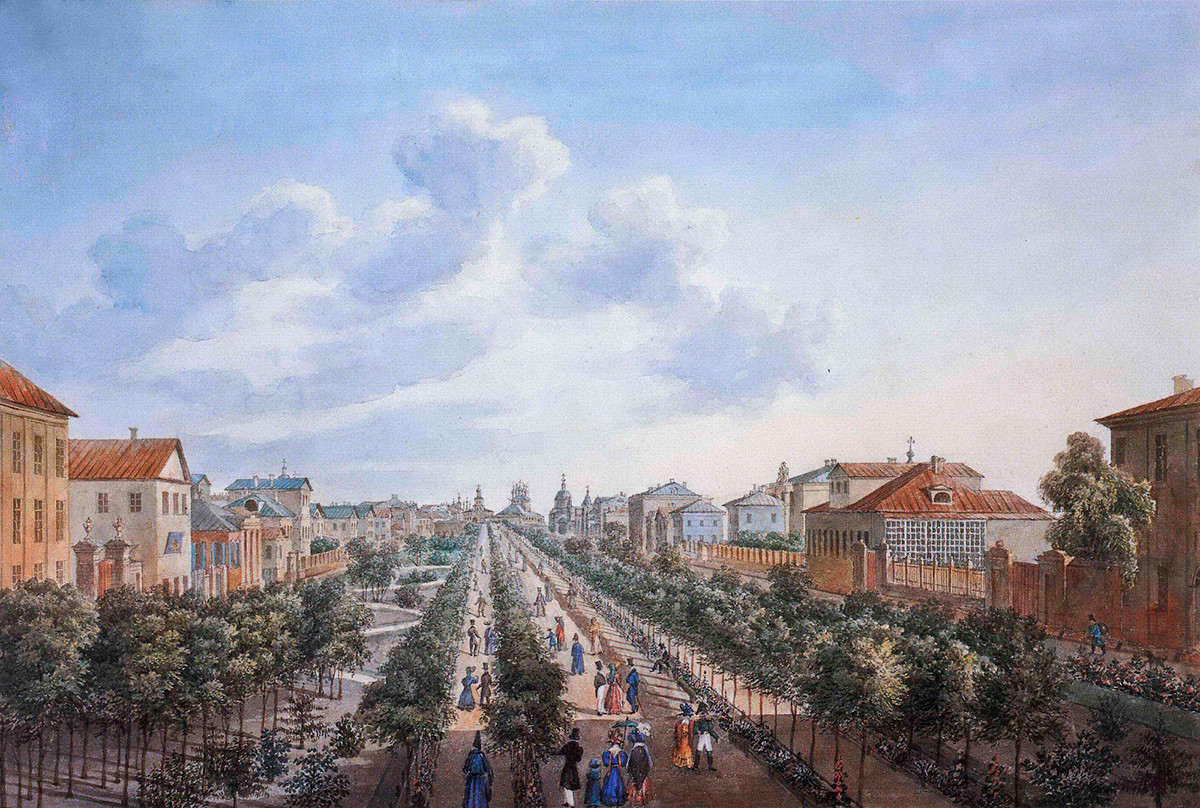
Tverskoy Boulevard in Moscow, early 19th century
Catherine the Great, who wanted to update the old capital, ordered the construction of the Boulevard Ring. It took the place of the obsolete Belyi Gorod (‘White City’) fortification wall.
“Moscow is encircled by boulevards – they are not only an ornament, but also an important benefit,” Vladimir Odoevsky, a 19th century Russian journalist, wrote. “When foreigners, looking at the plan of Moscow, see this green ring, we are proud to explain to them that in winter and summer, both sick and healthy, and the elderly, and children can walk around the city, walk between the trees and not be afraid of being hit by a carriage.”

The Kremlin ravine, the 1800s
After the fire of 1812, another green ring appeared – the Sadovoye (‘Garden’) ring, a wide street encircling the fast-growing center and covered in private houses’ gardens.
Greened by the Reds
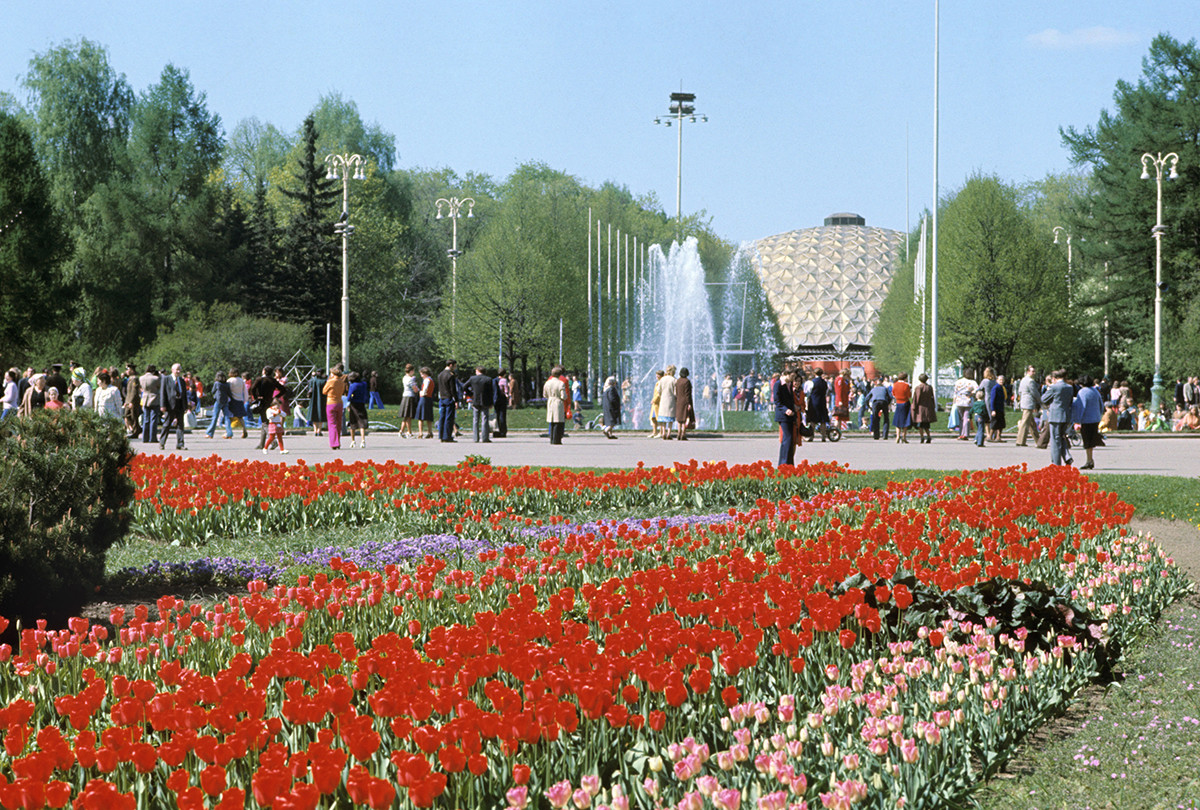
Sokolniki Park, Moscow
Rapid urbanization starting after the 1917 revolution brought swarms of new inhabitants to Moscow, and the old city had to adjust to the needs of the industrial state. Unfortunately, with the 1930s Stalinist plan of Moscow reconstruction, many historical buildings were demolished, and main streets turned into highways.
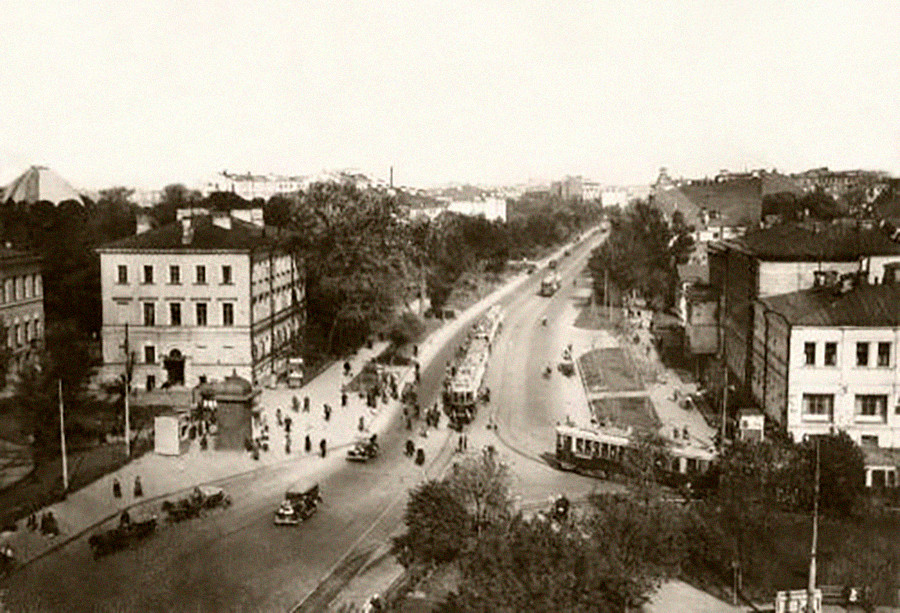
Sadovaya-Kudrinskaya, Garden Ring, Moscow, 1928
In the 1930s, the Garden Ring was paved, trees at many squares and streets were cut down, there even were plans to destroy the Boulevard Ring, but fortunately they were not carried out. Georgy Popov (1906-1968), a Moscow Communist Party official, remembered that after WWII, in 1947, Stalin personally supervised the plans for re-greening the city center: “I remember how quickly we were deployed. We planted greenery on Dzerzhinsky Square (now Lubyanka Square), and in Okhotny Ryad, restored the garden on Sverdlov Square (now – Teatralnaya Square), and planted on Bolotnaya Square. Gorky Street was preplanted from Manezhnaya Square to Belorussky railway station. This was the first step in the greening of the central part of the city,” Popov wrote.

Sadovaya-Kudrinskaya, Garden Ring, Moscow, 1936
In 1951, the Moscow government chose from as many as 272 projects for re-greening Moscow. By 1961, forestry workers had planted over 500,000 trees and shrubs in the city. Small-leaved linden, blue spruce, fir, western thuja, irga, golden currant, barberry, and roses.
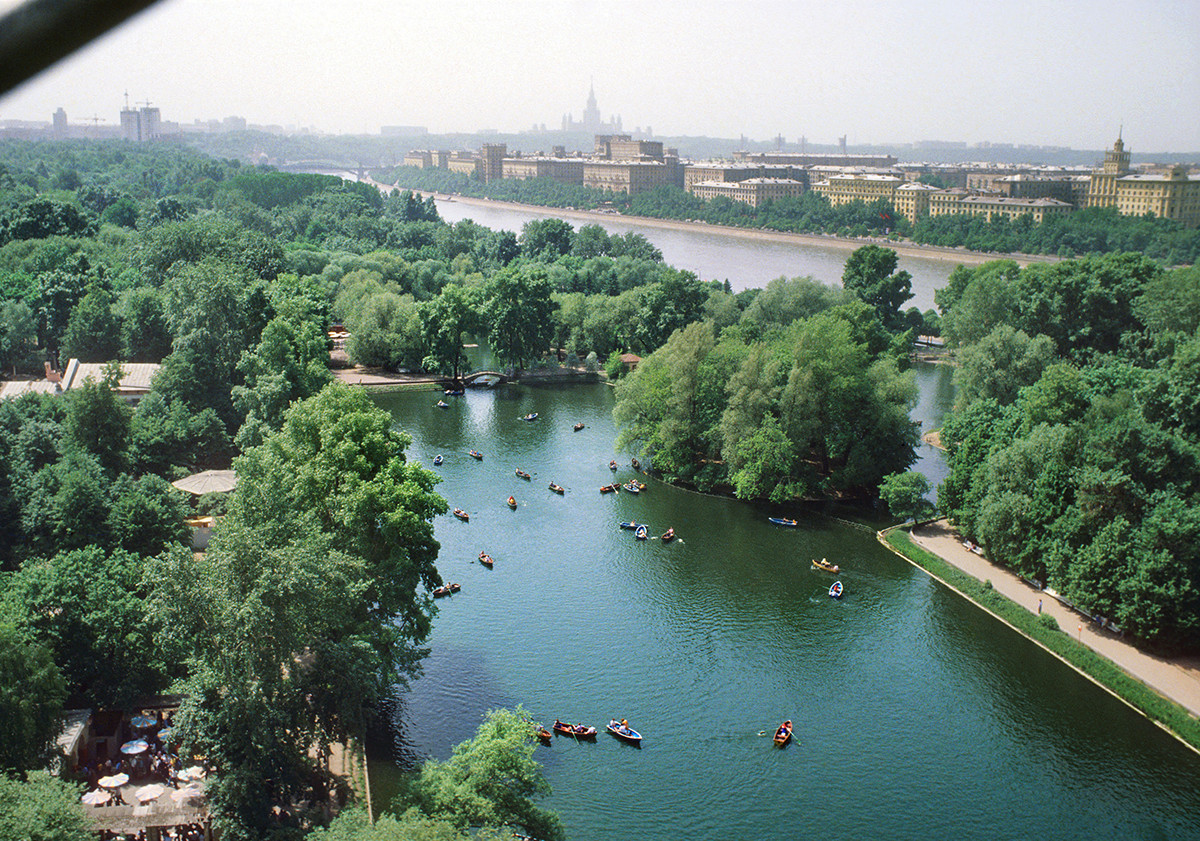
Gorky Park, Moscow, 1979
The 1950s-1960s also saw the reconstruction of Moscow’s biggest public parks. Gorky Park, transformed in the 1930s from Neskuchny (‘Merry’’) Garden, a 19th century public leisure space, has seen over 2,000 trees and 25,000 shrubs planted annually. The total space of the park expanded to 2.2 sq km, and the total length of the park’s alleys reached 30 km.
In the 20th century, more big parks were organized in Moscow: Sokolniki (5.16 sq km), Izmailovsky (16 sq km), Pokrovskoye-Streshnevo (2.22 sq km), Bitsevski Park (22 sq km), and, most importantly, Losiny Ostrov National Park (116 sq km), the largest urban park in Europe.
Felling a tree, planting two
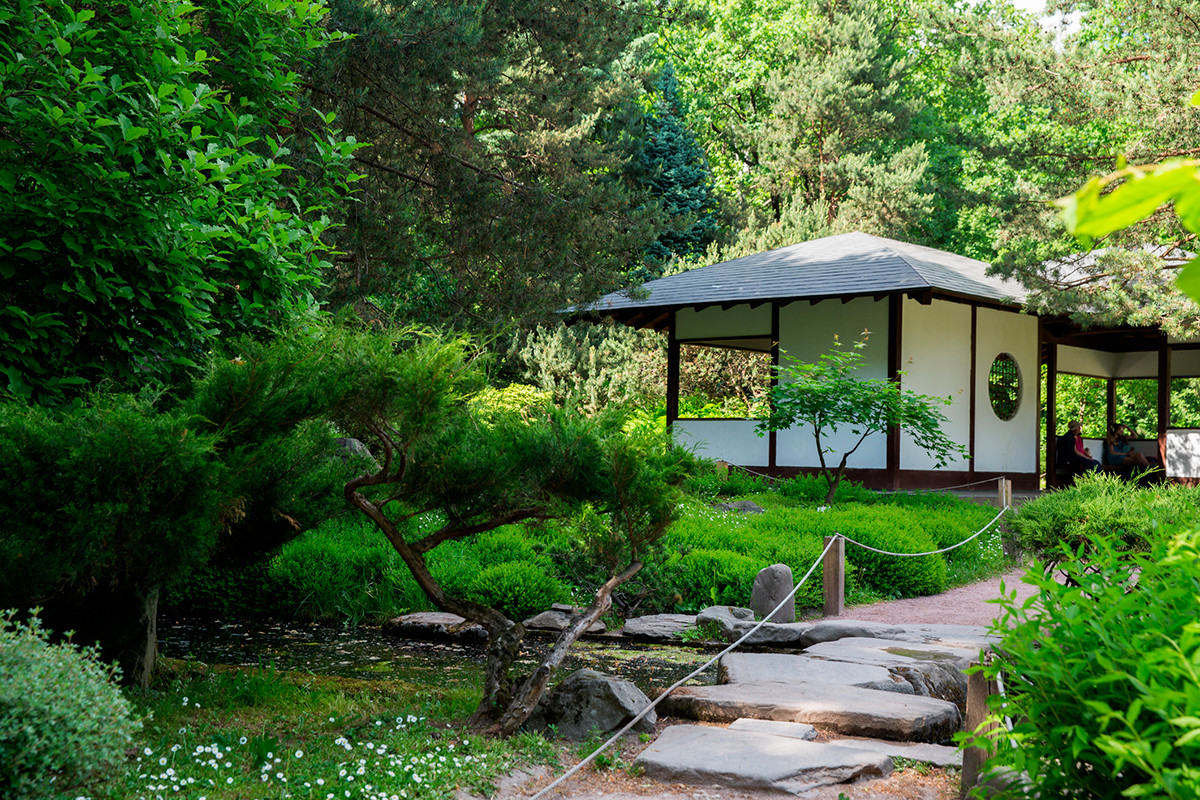
Japanese garden in Main Botanical Garden in Moscow
Currently, Moscow’s green affairs are under strict control from the city’s government. In 2010-2016, 432,000 trees and 3.5 million shrubs were planted, and since 2013, a government initiative called “A Million Trees” has been implemented, meant to plant vegetation inside the inner yards of apartment buildings, with the plants being chosen on a digital app platform by locals.
Cutting down a tree in Moscow (for example, during a house construction) is very difficult, and if you still have to resort to such a measure, then the developer is obliged to compensate for this by planting two trees. However, these rules do not yet apply to other Russian regions, even in close proximity to the city – for example, the Moscow Oblast’. In 2007-2012 in Khimki, a suburb in Moscow Oblast’, a part of forest containing ancient oaks was being cut down for a road construction project. The project was eventually implemented, and a section of toll road was organized, causing air pollution near the highway, and in addition, noise pollution in the forest.
According to Moscow government’s official portal , by the end of the year, over 5,000 trees and 136,000 shrubs will be planted in Moscow, so the city is not going to lose its status as the greenest capital of the world any time soon. However, the indexes of the air pollution in Moscow are still unfortunately high – the city is still Russia’s largest trade and industrial center. The World Air Quality index places Moscow in 27th place in the air pollution ranking.
If using any of Russia Beyond's content, partly or in full, always provide an active hyperlink to the original material.
to our newsletter!
Get the week's best stories straight to your inbox
- 7 more unusual houses of Moscow
- The most fairy-tale houses of old Moscow (PHOTOS)
- 7 MOST extravagant houses of 19th century Moscow
This website uses cookies. Click here to find out more.

Mission Moscow : A Conversation with Evgeny Kozlov
Mr. Evgeny Kozlov, Deputy Head Mayor of Moscow Government and Chairman of the Moscow City Tourism Committee, who has come to the city to attain BLTM, the annual prestigious travel event at the Leela Ambience Convention Centre, Delhi spoke with TW Editor Anirban Dasgupta on his vision and goal with the all-new tourism initiatives in Moscow.
The bond between India and Russia has a long history of culture, literature, love, and of course politics. But recently, there has also been a lot of talk about Gastronomical tourism. Any personal experience with this?
My personal take on the bond between India and Russia stems from my recent experience of trying authentic Indian cuisine in Moscow. I thoroughly enjoyed the spicy flavours of the Curry dish I tried and it left a lasting impression on me. This made me appreciate the cultural exchange between our two countries even more. I believe that Moscow, being a culinary hub, is a great place for people from all over the world, including Indian visitors, to immerse themselves in our rich history and culture. It’s a unique experience that brings people together and showcases the diversity of the gastronomic universe. Moscow has a thriving food scene with various international cuisines to explore, from Chinese to South African and Latin American. This culinary diversity reflects the open-mindedness and curiosity of the Russian people when it comes to trying new types of food. Moscow truly has something for everyone, and I encourage Indian tourists to come and indulge in this gastronomic journey.

How optimistic are the post-pandemic recovery figures?
After the Covid-19 pandemic, we have witnessed a remarkable recovery in tourism in Moscow. In fact, we have been able to restore 90% of the pre-pandemic tourist flow. In the first half of 2023, almost a million foreign tourists visited Moscow, with over 600,000 of them arriving during the summer season. Among the non-CIS countries, China has led the way in terms of tourist traffic, followed by Iran, the United Arab Emirates, Turkey, and India. Prior to the pandemic, India’s tourist flow was steadily growing at a rate of 12-15% annually. Although we faced challenges during the pandemic, we have now put in place all the necessary conditions for a successful recovery. Moscow is known for hosting numerous international exhibitions, forums, congresses, and conferences, attracting approximately 3.6 million business visitors in the past year alone. Among these visitors, India ranks third in terms of foreign business tourists in Moscow. To further promote tourism, we have initiated the MICE Ambassadors training program in India, which aims to assist Indian businesses in exploring opportunities and selecting relevant events in Moscow.
Can you please share your vision for future tourism development in Moscow?
Thank you for asking this question. I have a multi-faceted vision for the future tourism development in Moscow.
Firstly, I believe that tourism should provide a personal and authentic experience for each individual. Therefore, customization of experiences is crucial. For business tourists, we aim to offer special infrastructure facilities that cater to their specific needs and requirements. We are closely collaborating with infrastructure providers to ensure seamless experiences for those visiting Moscow for business purposes. On the other hand, when it comes to leisure or family tourists, we recognize the importance of providing a support system and guidelines for those traveling with their families, especially children. We are working with museums, theatres, and restaurants to customize their services and products to cater to tourists of all ages, including children. Furthermore, I envision rearranging tourism in Moscow to encourage visitors to delve into the history and heritage of our country. A significant part of my tourism goal is to motivate and inspire the youth and younger generations to travel to Russia. This involves providing affordable pricing for accommodations, entertainment, museums, and other attractions.
We are already constructing tailor-made infrastructure that specifically targets the young generation in Russia, and by next year, we plan to extend and promote these offerings to international young visitors as well. By rebranding the image of Moscow as a destination for longer stays, relaxation, and enjoying various facilities, we aim to change the perception that it is merely a transit or stop-over city. Lastly, the beautiful weather in Moscow during the summer months provides an opportunity to create delightful memories for tourists. I want every visitor to experience the sunshine, green landscapes, parks, cafes, restaurants, swimming pools, and sports facilities that Moscow has to offer during this time.
In summary, my vision for the future of tourism in Moscow revolves around creating customized travel experiences for every type of traveller.
How do you prioritize sustainability and responsible tourism practices in the development of business tourism?

How easy or difficult is it to get a Visa for an Indian Tourist at present?
Acquiring a Visa for Indian tourists has become easier with the introduction of the e-visa system. Since its launch in August 2023, more than 30,000 tourists have already utilized this system. The e-visa offers several advantages over traditional visas, such as avoiding the need to visit consulates or embassies. The application process only requires a digital photograph and a scan of the passport data page. The e-visa has a validity period of 60 days from the date of issuance, with a maximum stay of 16 days in Russia. This convenient and streamlined process is available to citizens of 55 countries, including India. Indian tourists are currently ranked third in terms of business travellers from outside the CIS countries visiting Moscow.
Author: Anirban
Share article, related news.

BLTM 2023 showcases top destinations for Bleisure and MICE Travel

École Ducasse Abu Dhabi Studio, in partnership with Erth Hospitality, to open this December
No comment be the first one., leave a reply cancel reply.
Your email address will not be published. Required fields are marked *
Save my name, email, and website in this browser for the next time I comment.

IMAGES
VIDEO
COMMENTS
The importance of sustainable tourism is also highlighted in SDG target 12.b. which aims to "develop and implement tools to monitor sustainable development impacts for sustainable tourism that creates jobs and promotes local culture and products". ... 16-Feb-2016 : A/70/472 - Sustainable development: report of the Second Committee ...
Sustainable tourism development requires the informed participation of all relevant stakeholders, as well as strong political leadership to ensure wide participation and consensus building. Achieving sustainable tourism is a continuous process and it requires constant monitoring of impacts, introducing the necessary preventive and/or corrective ...
Sustainable tourism considers its current and future economic, social, and environmental impacts by addressing the needs of its ecological surroundings and the local communities. This is achieved ...
16 Sustainable Tourist Experiences & Destinations Around The World. 1. Table Mountain Cableway, South Africa. Best time to visit: March to May and September to November. The sustainable Table Mountain Cableway is the way to go if you want to reach the 1086m-high pinnacle of Table Mountain without breaking a sweat.
This day highlights the importance of sustainable tourism —a framework for engaging travelers and the travel industry at large in supporting goals that include protecting the environment ...
Travel and tourism are bouncing back from Covid-19 and are expected to reach $17 trillion by 2027. The increasing demand for sustainable tourism is not limited to eco-warriors who choose niche experiences and exclusive sustainability offerings. It is simply an appetite to travel sustainably and make more responsible choices.
Sustainable tourism is a concept that covers the complete tourism experience, including concern for economic, social, and environmental issues as well as attention to improving tourists' experiences and addressing the needs of host communities. [1] Sustainable tourism should embrace concerns for environmental protection, social equity, and the ...
The company is currently reassessing the amenities used in their 18 hotels nationwide, which collectively use around 16 tons of plastic each year, and aims to cut down the plastic used in amenities by over 90% by 2024. ... To achieve sustainable tourism that considers environmental, social and economic impacts, it is essential to change the ...
1 Sustainable Tourism as a Development Tool 16 2 Key Issues for Sustainable Tourism 21 3 Relating Tourism to Development Priorities 23 4 Stages in Identifying and Executing Interventions 29 4.1 Starting Points in Practice 30 4.2 Assessment of the Situation and Identification of Needs 31 4.3 Selection of Interventions 32
and decent work, SDG 12 on sustainable consumption and production, and SDG 14 on sustainable oceans (in targets 8.9, 12.b and 14.7 respectively) - and the World Tourism Organization firmly believes that tourism can play a role in the achievement of all 17 SDGs. Tourism is a social, cultural and economic phenomenon.
A few topics, for example, eco-tourism, rural tourism, tourist management and planning, and marketing strategies for sustainable tourism (Topics 2, 3, 14, 16, and 23) have followed a declining trend, which suggests that academic research in these areas may have reached a maturity level and researchers' attention has shifted toward more novel ideas.
Definition of Sustainable Tourism. Sustainable Tourism refers to sustainable practices in and by the tourism industry. It is an aspiration to acknowledge all impacts of tourism, both positive and negative. It aims to minimize the negative impacts and maximize the positive ones. Negative impacts to a destination include economic leakage, damage ...
Journal overview. The Journal of Sustainable Tourism is a leading tourism journal which advances critical understanding of the relationships between tourism and sustainable development. It publishes theoretical, conceptual and empirical research that explores one or more of the economic, social, cultural, political, organisational or ...
tourism stakeholders, and communities to ensure that the benefits of tourism are equitably distributed, and that the sector operates in a responsible, inclusive, and sustainable manner. By doing so, tourism can help to promote SDG 16 and contribute to long-term peace and stability in societies
The need for more sustainable tourism has long been recognised, and the COVID-19 pandemic precipitated renewed calls for large-scale and rapid transformation of the sector. ... (Scenario R) was the least predicted outcome (for 16.5% and 28.0% of respondents, respectively). Where Scenario R was the preferred future, Scenario U was the second ...
There are nine targets within SDG 16 that are deemed to have a stronger and direct link for tourism to promote peaceful and inclusive societies for sustainable development, provide access to justice for all and build effective, accountable, and inclusive institutions at all levels. These targets have been selected to base the potential project ...
Make it a practice to donate, every time you fly. 2. Travel slowly for sustainable tourism. Rather than hopping from one place or city to another every 1 to 3 days, spend as long as possible in a place. Spending more time in a place enables tourists to better connect with the destinations they visit.
Small towns like Giethoorn, Hallstatt, and Cinque Terre showcase sustainable tourism practices with car-free streets, eco-friendly transportation, and a focus on waste management, preserving ...
World Heritage partnerships for conservation. Ensuring that World Heritage sites sustain their outstanding universal value is an increasingly challenging mission in today's complex world, where sites are vulnerable to the effects of uncontrolled urban development, unsustainable tourism practices, neglect, natural calamities, pollution, political instability, and conflict.
After the Green Paper on Sustainable Tourism - Experience Programs was published by UN/CEFACT in April 2019, the working experts of Travel and Tourism domain found it necessary to develop the business standards for sustainable tourism. This white paper suggested ten categories according to the service content or products provided by the ...
Discover how to maximize sustainable tourism benefits with practical tips on eco-friendly travel and engaging with local communities responsibly.
Global Code of Ethics for Tourism; World Committee on Tourism Ethics; Ethics Convention; Accessibility; Tourism and Culture; Women's Empowerment and Tourism; COVID-19: Sociocultural Impact; Technical Cooperation. Silk Road; UN Tourism Academy. Courses, Webinars & Resources; UN Tourism Executive Education; UN Tourism.QUEST; UN Tourism.TedQual ...
According to WorldAtlas, 54 percent of Moscow's territory is covered by public parks and gardens, making it the greenest city in the world. There are 20 square meters of trees and shrubs per ...
Mr. Evgeny Kozlov, Deputy Head Mayor of Moscow Government and Chairman of the Moscow City Tourism Committee, who has come to the city to attain BLTM, the annual prestigious travel event at the Leela Ambience Convention Centre, Delhi spoke with TW Editor Anirban Dasgupta on his vision and goal with the all-new tourism initiatives in Moscow. The bond between India and Russia has a long history ...